Venice Biennale 2024 with the title: “Foreigners Everywhere”. Contemporary Art Star MOHRI Yuko @ Japan Pavilion. Can MOHRI challenge ‘L’Arte dei rumori’ by Italian Futurist Russolo? ヴェネツィア・ビエンナーレ 2024のテーマ:「外人だらけ」。現代美術のスター 毛利悠子 @ 日本館。
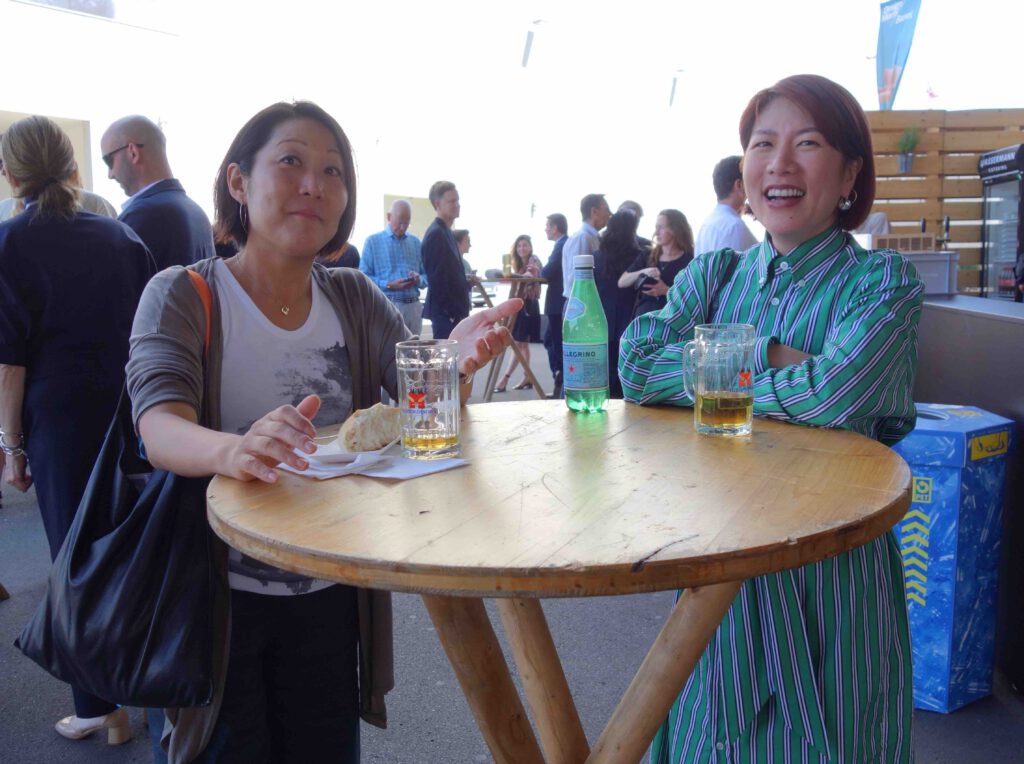
From Basel, my sincerest congratulations Yuko! Also from Art Basel. Finola and David are very much looking forward to your next solo show at their mother’s tankstation in London this September! David: “We are obviously very proud and very excited that Yuko will represent Japan…”
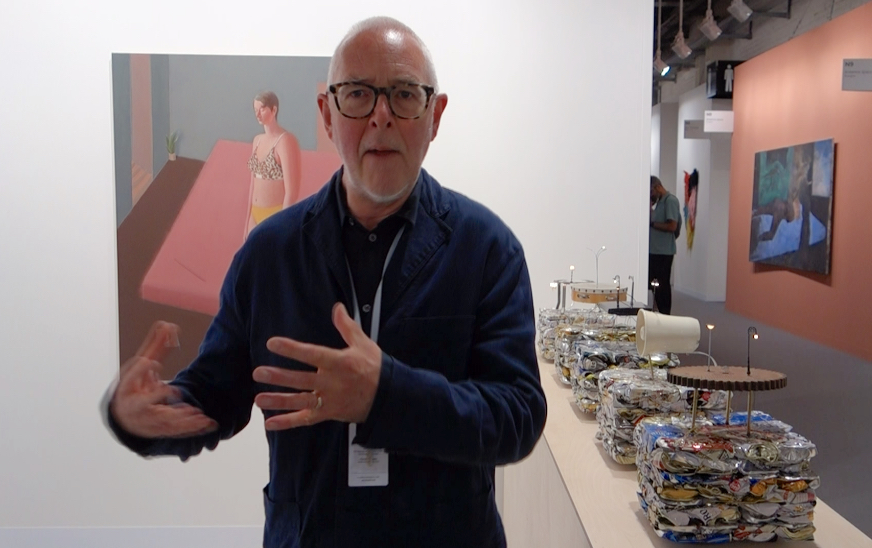
With the announcement by the Japan Foundation on the 12th of this month, that artist MOHRI Yuko 毛利悠子 had been chosen for a solo exhibition in the Japan Pavilion at the 60th Venice Biennale in 2024, I may hereby proclaim: a new contemporary art star is born!
We are all genuinely electrified in experiencing Yuko’s new installation work @ Bella Venezia!
About 20 years ago, my then art dealer MIZUMA Sueo 三潴末雄, buddy artist AIDA Makoto 会田誠 and I, we three were sitting alone at a bar counter in posh-stylish Minami Aoyama, Tokyo.
Among other things (like Mizuma’s empty money wallet), it was about the question of what we could still create groundbreaking new as artists.
After long discussions, my “final words” were… it’s all been there. Italian Futurism has already anticipated contemporary art practice. It will be really difficult, hardly possible anymore, for any artist to create something really new, original.
Silence in the bar.
Silenzio.
MOHRI Yuko a Venezia 2024.
Everybody knows the futurist Luigi Russolo. Not an easy stand for Yuko in Italy.
About 30 years ago, silence in the music-composer room. Alone with TAKEMITSU Toru 武満徹.
I asked him if he didn’t think that Western music had already explored every kind of musical possibility? How will he, as a composer, still create something original?
“The eclectic forms of sonorous expressions of Japanese musical instruments such as the Biwa lute, or the Shakuhachi flute, or even the wind among the bamboo groves, will help me to accomplish this task.”
“Well, there exist no bamboo groves here in Karuizawa…” I replied.
Silence in the music-composer room.
Silenzio.
MOHRI Yuko a Venezia 2024.
Constructing and de-constructing sounds, noises from Japan. A high challenge set, demanded by the art-cultivated Italian audience.

Compressed can, light models, streetlight models, used cable, trivet, lens, tambourine, internet hub, horn speaker, wooden gear. Dimensions variable (As installed: 125 x 250.5 x 49 cm)
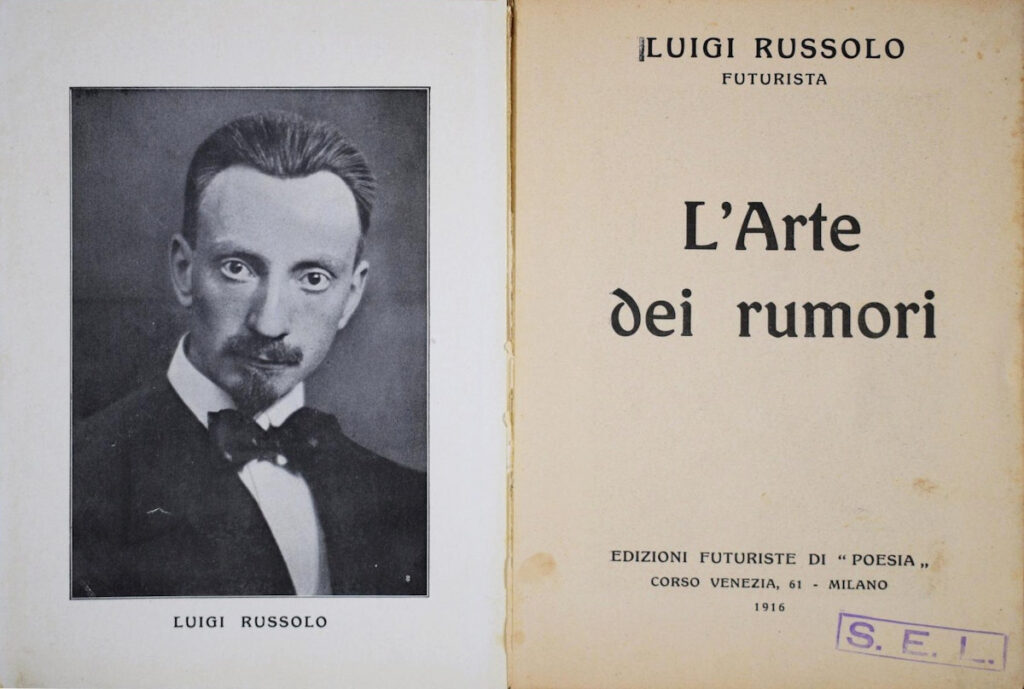
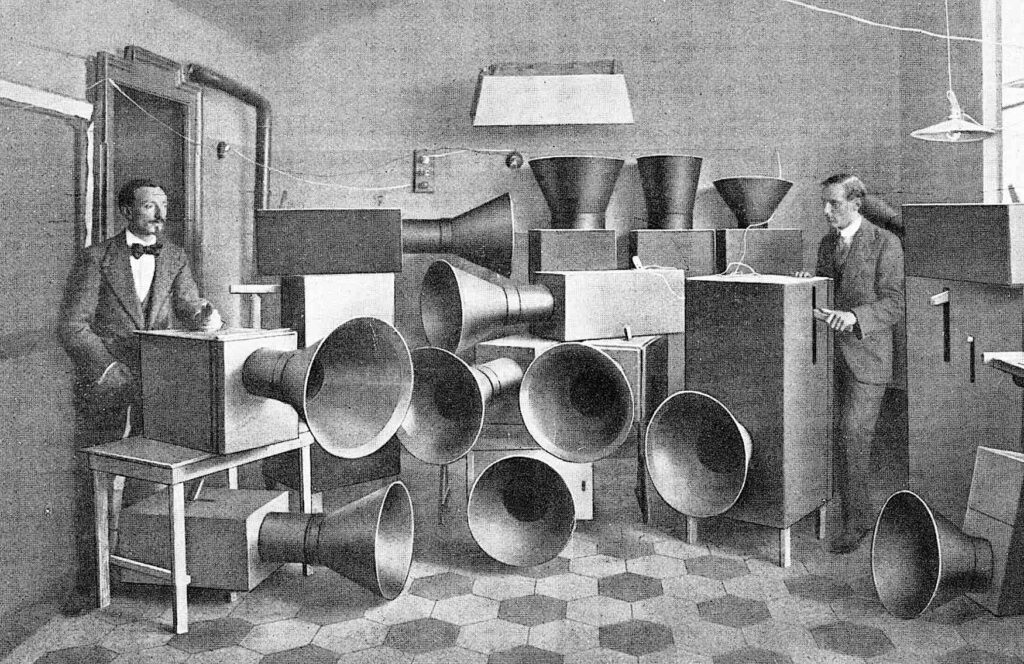
My question in the title “Can she challenge ‘L’Arte dei rumori’ by Italian Futurist Russolo?” is meant as a rhetorical question and implies a discourse as to whether it will still be possible to create new sound structures today after Russolo or John Cage or Einstürzende Neubauten.
To avoid any misunderstandings, such a rhetorical question is also aimed at the Japanese readership, which may not be too familiar with futurism. I also believe that Yuko has the necessary mental strength to meet the requirements and expectations of an internationally oriented Venice Biennale. She’ll feel free and do her thing, I’m absolutely convinced of that.
What might the noise sound like in the future? What kind of ideas does the artist MOHRI Yuko have?
Exactly 110 years ago, Russolo explored the possibilities of expanding and enriching the field of sound in his manifesto “The Art of Noise”. He raved about the soundscape of the modern city, i.e. Milano, the pounding of the valves, the driving of the pistons, the screeching of the mechanical saws. For Russolo, the noisy nature of everyday, industrializing Europe offered new ways of perceiving the acoustic world and a means to free concert music from its stagnant orchestral roots. In fact, Russolo’s theories of sound were based on assumptions about the role of the senses in human life, about energy, perception and heightened emotional states.
At this point, Yuko’s artistic practice will probably deviate, adding a slightly more Japanese contemporary, socially critical component.
Let me quote Yuko, taken from her Facebook page:
“What I am interested in is how a crisis, paradoxically, sparks the highest levels of creativity in people. This realisation served as the fundamental inspiration for this project, triggered by witnessing railway workers in Tokyo ingeniously employing everyday items to stop water leaks at stations. The belief grew stronger within me after observing how the COVID-19 pandemic unfolded, becoming a global catastrophe that transformed everyday life across the world.”
The artist Jean Tinguely is considered as one of the main representatives of kinetic art and best known for his moving, machine-like sculptures. Closely intertwined with the city population of Basel, as every child played in the carnival fountain (Fasnachts-Brunnen) on the Theaterplatz or visited the Tinguely Museum with the school class.

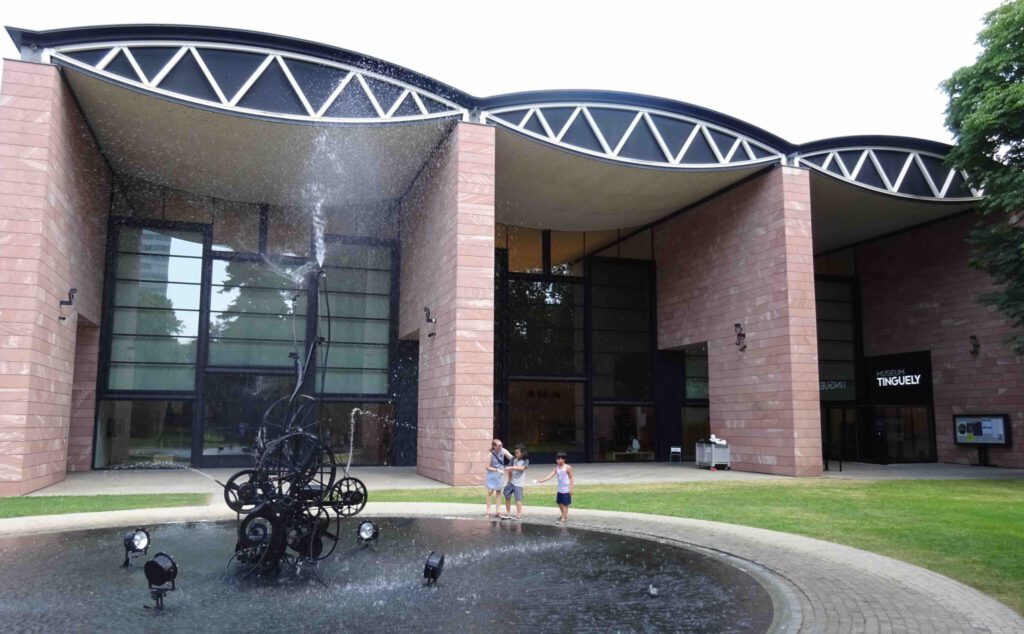
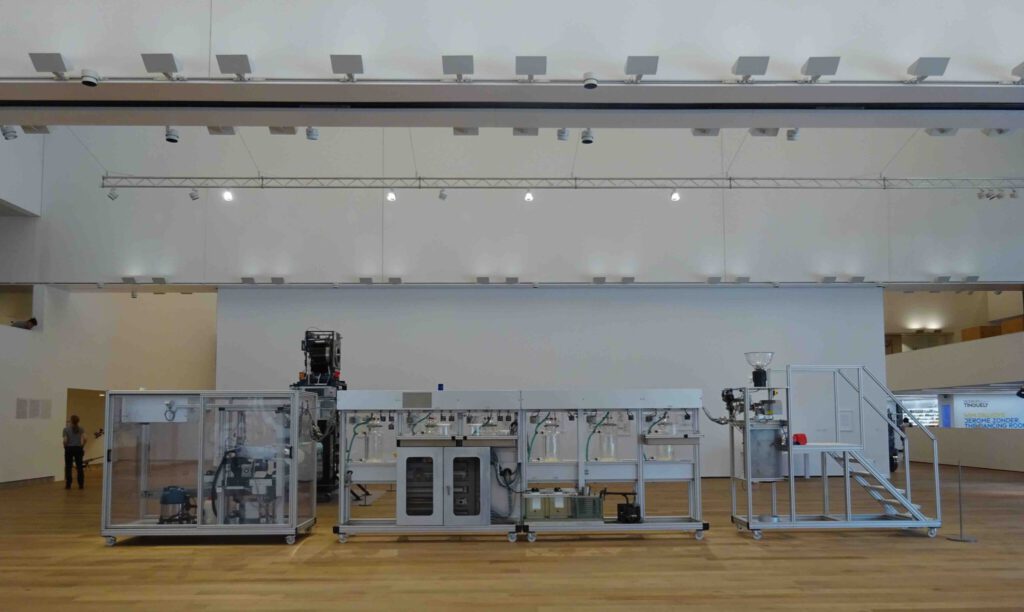
When I met Yuko last year at Art Basel, I told her that I wished to see her works one day in the nearby Tinguely Museum, as her installations perfectly match its concept.
Together with architect KOMURO Mai 小室舞 she later visited the museum and received probably some inspirations.
This extremely popular museum functions as an interactive environment where children can participate and being playfully introduced to the appreciation of kinetic art. For this reason too, the Basel audience at Art Basel can be regarded as highly art-educated and open-minded when it comes to contemporary art.
Recapping, I first noticed Yuko many years ago at the Art Fair Tokyo in conjunction with her then local gallery ‘waitingroom’. She was showing her photographs of rain leaks in the Tokyo subway that were makeshift reroutes by station staff. She began taking these kind of pictures in 2009; each leak implied a self-sufficient ready-made for Yuko, in part because banal, everyday objects were used as makeshift utensils.
This is where her first prototype works, titled “Moré Moré” (漏れる moreru = to leak), were executed. At the Art Basel 2022 booth of mother’s tankstation a sophisticate version “Moré Moré (Leaky): Vitrine #4” from the same year found its collector, see the pics below.
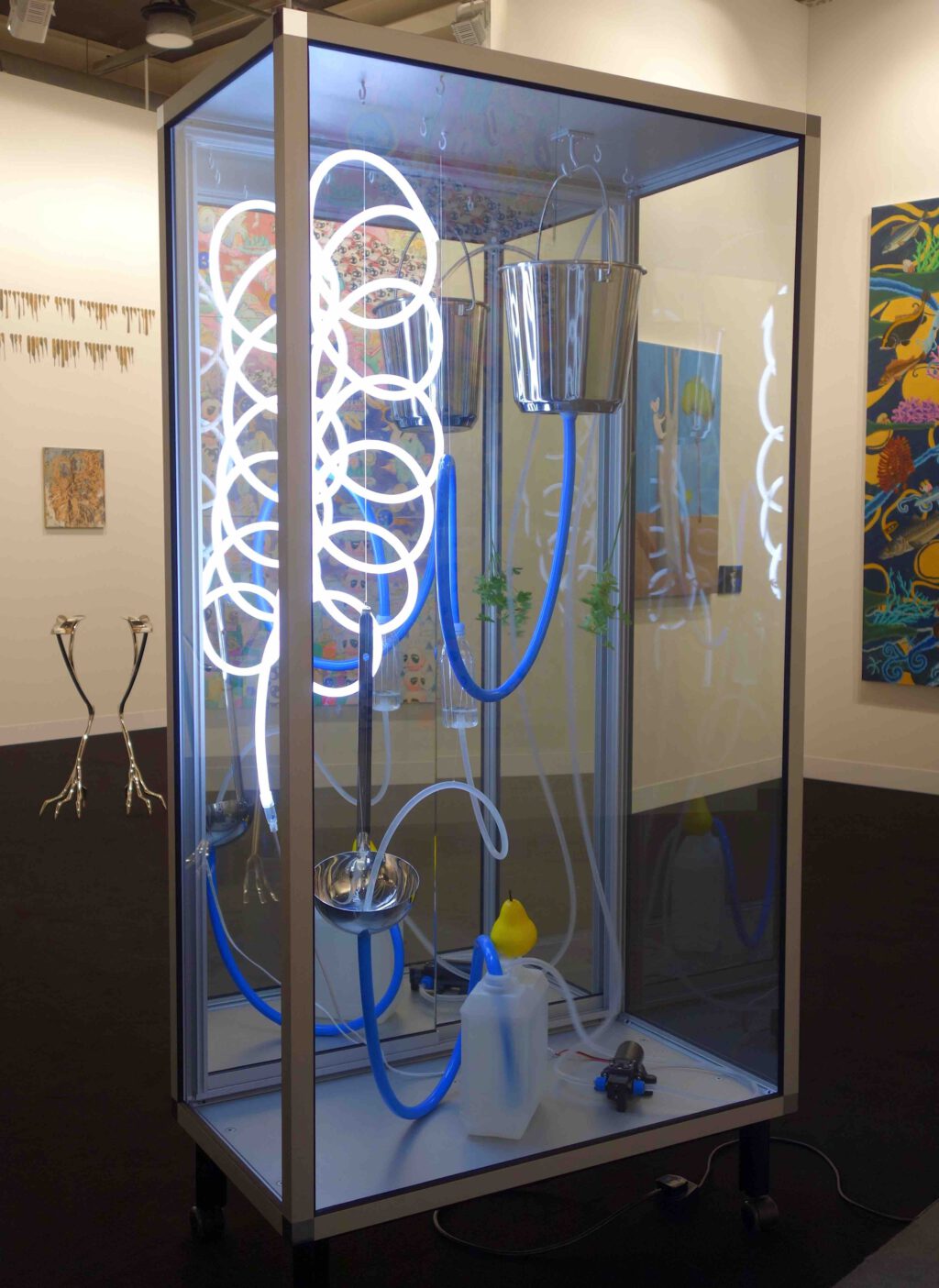
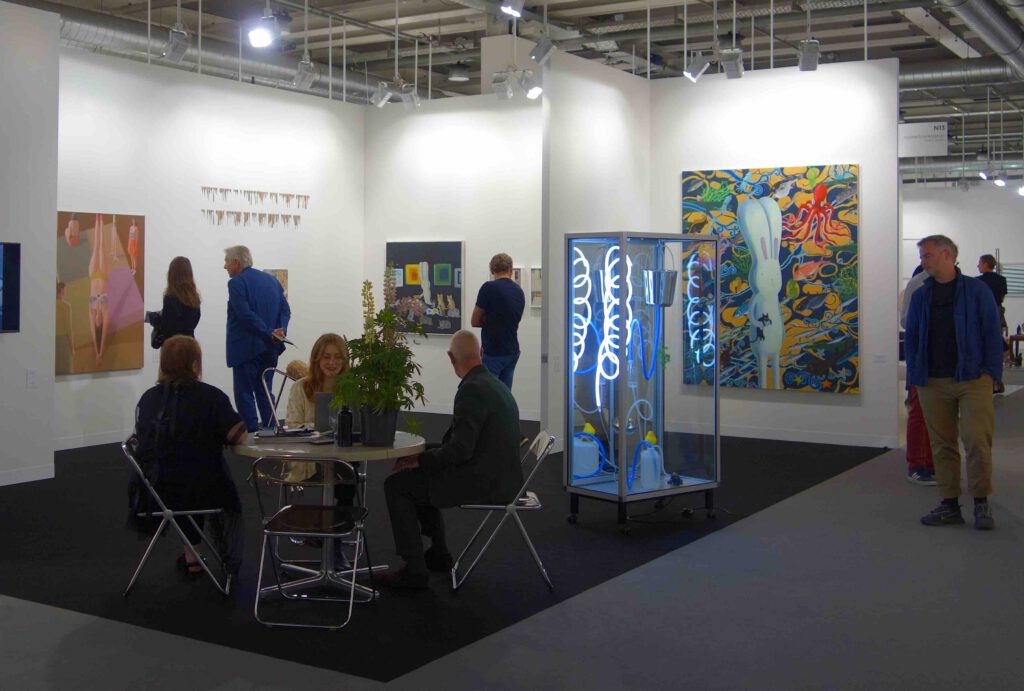
The big career leap for Yuko happened with the invitation to the Yokohama Triennale 2014; artistic director was fellow artist MORIMURA Yasumasa 森村泰昌 with his overall theme: “ART Fahrenheit 451 – Sailing into the sea of oblivion”.
Yuko showed the installation “I/O – Chamber of a Musical Composer”「アイ・オー ―ある作曲家の部屋」(2014), whose title anticipates the future of her artistic practice. In essence, she recognizes herself in the genre of music composing. See the pic below:
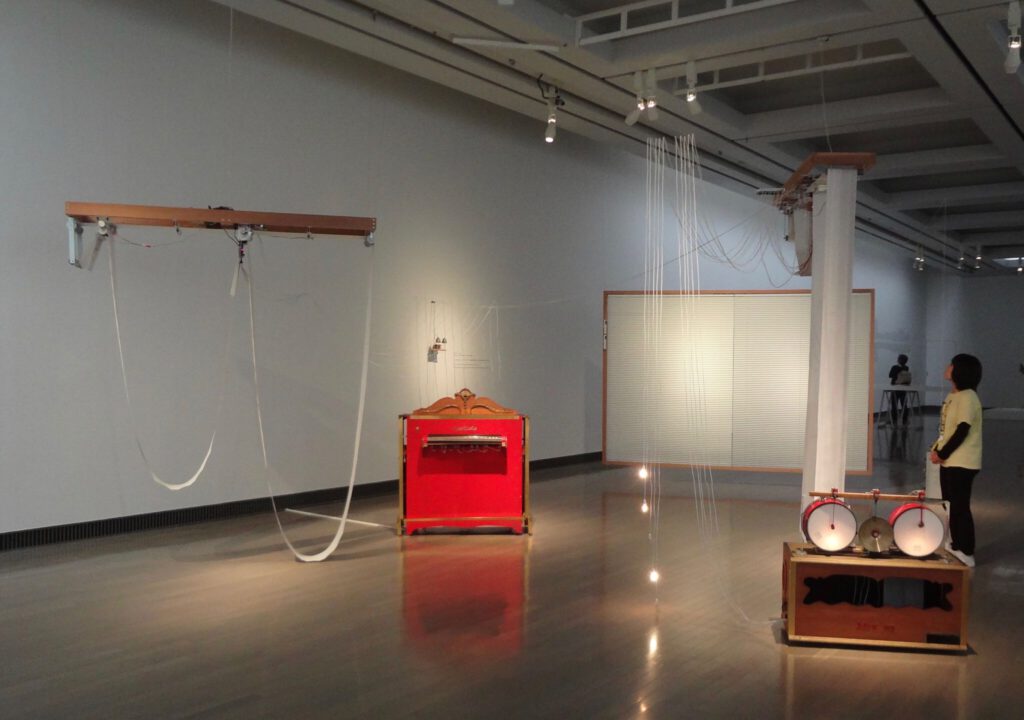
A4のロール紙、モーター、毛ばたき、ベルリラ(鉄琴)など様々な素材で構成された作品
The work is composed of various materials such as A4 paper rolls, motors, hair flaps and Bell Lyra (metallophone) a.o.
As we now know, “I/O: Chamber of a Musical Composer” is an assemblage of kinetic sculptures and conceived as an ongoing series. Intended less as a work-in-progress than an adaptation to the spiritus loci of the exhibition site. Yuko seems to research about the local habitat and showing empathy for the history of that country, of that city, ergo trying to incorporate its historical elements into her body of work.
Normally, “I/O: Chamber of a Musical Composer” is an installation in which endless rolls of paper suspended from wooden frames on the ceiling slowly unfold and fall down to touch the floor. When they are rolled back up, they have collected (in a less obvious way) traces of dust and dirt created during this fleeting moment of surface contact.
These traces then provide an automated score for a series of musical instruments spread across the room and decorated in carnivalesque colours, tapping, ringing and wheezing seemingly at random. The instruments are also connected to a series of flashing lights and a framed blind that opens and closes as a current passes through it, acting as a substitute for a stage curtain or backdrop (depending on your point of view) for the performance.
In the case of the Yokohama Triennale, one senses an homage to Victor Clark Searle ビクター・C・セアル, who worked as a musician, composer, and teacher in Japan.
東北学院大学グリークラブOB(指揮:Victor Clark Searle 先生)
Searle’s self-made Glockenspiel, which Yuko had inherited, was deliberately infiltrated into “I/O: Chamber of a Musical Composer”.
more @
美術作品を残すということ 計測する作家・毛利悠子インタビュー
https://bijutsutecho.com/magazine/interview/257
Documentary In Progress
https://www.facebook.com/d.i.p.executive.committee/
At the ongoing Gwangju Biennale, titled “soft and weak like water”,
Yuko Mohri [Born 1980 Kanagawa ken | Lives and works Tokyo] @ Gwangju Biennale 2024
https://www.gwangjubiennale.org/en/eventCH/author/work.do?B_AU_KEYNO=11526&searchCondition=1&searchKeyword=
Yuko has also given her “I/O” installation a site-specific impetus by creating a connection to female novelist HAN Kang 한강, 韓江, who was born 1970 in the same city, Gwangju. https://han-kang.net
In addition to collecting almost invisible dust and debris from the ground and sensing environmental elements such as air currents and humidity, Han’s novel “The White Book” 흰 from 2016 receives an important place in Yuko’s oeuvre. This is to symbolise the sad, multi-layered history of the city, the creation of a “sound of history that was never written.”
As someone who witnessed the 1987 presidential election campaign in Gwangju (see my books “Korea – Geteiltes Land” and “분단 한국” (Bundan Hankuk) 1988/1989 available in South Korea and in Germany) I greatly appreciate this kind of serious, allegorical attitude by Yuko.
Although the process by which Yuko’s installations are created is a large part of her practice, we recognise that the objects she uses are chosen with care.
“In Japanese,” she explains, “there’s an expression ‘The beauty of use’ 用の美 (Yo no bi), meaning the illumination of everyday objects through their use.”
It’s a concept that’s often applied by us artists. Taking something mundane and elevating it to an art object à la Duchamp.
Yuko’s intention, of course, transcends to a meta-physical level, to underpin her deep appreciation for each, conscientiously chosen object.
I see parallels in this kind of art practice to SHIOTA Chiharu’s 塩田千春 installations, which I may envision as especially appealing to female ‘Spiritual Seekers’, contemplating in an art exhibition.
check:
塩田千春作:孤独と生命線の神秘な相関巣 (過去サイト・アーカイブの再投稿、2013年2月3日)
SHIOTA Chiharu: Mysterious Nest-specific Correlations Between Loneliness and Lifelines (repost from the archive, 2013/2/3)
https://art-culture.world/articles/shiota-chiharu-shiota-塩田千春/
塩田千春展 「魂がふるえる」@ 森美術館、総入館者数が66万6千人を記録
SHIOTA Chiharu “The Soul Trembles” @ Mori Art Museum Tokyo closes with a record number of visitors: 666.000
https://art-culture.world/articles/mori-art-museum-shiota-chiharu-森美術館-塩田千春/
May I continue with Yuko’s carefully thought statement regarding her Venice Biennale participation, in which she cited the efforts of two young climate change activists who tossed tomato soup over the glass protecting van Gogh’s 1888 Sunflowers at London’s National Gallery in 2022 as an inspiration a.o..
Original statement published at the website of the Japan Foundation:
■毛利悠子コメント いつかわたしたちはみな蒸発するだろう ――オノ・ヨーコ
2022 年、ナショナル・ギャラリーに展示されているヴァン・ゴッホ《ひまわり》にトマト缶をかけた環境保護団体ジャスト・ス トップ・オイルによる抗議行動は記憶に新しい。美術誌『frieze』編集長による実行者 2 名への取材では、「洪水で被災 した 3300 万人のパキスタン人」への無関心と、たった 2 名の西欧世界からの抗議への注目という非対称性が行動理由 に挙げられている。活動家が主張したアートへの攻撃は、先進国ではまだ認識さえもされていない、地球上の多くの生態 に影響を及ぼす気象危機の関心を大きく集めることになった。2人はゴッホにトマト缶をかけた後、こう主張した――「より 価値があるのはアートか、それとも命か?」
危機は逆説的に、人々に最大の創造性を与える――これは東京駅構内で起こる水漏れに日用品を用いた ブリコラージュ
(不)器用仕事で立ち向かう駅員たちのフィールドワーク「モレモレ東京」を着想するに至った根幹であり、また、世界的 な厄災となったコロナ禍でますます確信した私の信念だ。2019 年に「50 年に1度の」洪水に見舞われたヴェネチアに て、アートの近傍で起こる世界的問題を剔抉し、創造的なヴィジョンを提示したいと思う。
English text taken from her Facebook page:
Someday we’ll evaporate together. ——Yoko Ono
Do you remember the protest by two young climate activists who threw canned tomato soup over Vincent Van Gogh’s Sunflowers (1888) at the National Gallery, London in 2022? In an interview with the two Just Stop Oil activists conducted by the editor-in-chief of the art magazine frieze, they pointed out the glaring disparity between the apparent indifference of the general public towards the 33 million Pakistanis affected by the catastrophic floods brought by climate change and the generous attention that mainstream media lavished on the duo’s attack on a work of art. The intention behind staging a protest using art, the activists claimed, was to draw attention to the climate crisis, which the developed world has not acknowledged, let alone taken any action against, despite its devastating effect on so many lives on our planet. The fundamental question posed was, “Which is more valuable, art or life?”
What I am interested in is how a crisis, paradoxically, sparks the highest levels of creativity in people. This realization served as the fundamental inspiration for this project, triggered by witnessing railway workers in Tokyo ingeniously employing everyday items to stop water leaks at stations. The belief grew stronger within me after observing how the COVID-19 pandemic unfolded, becoming a global catastrophe that transformed everyday life across the world. Venice also experienced a cataclysmic, once-in-50-years flood in 2019. Sensing the beginning of a fresh era of response to global challenges, I want to present an innovative vision that opens a new path to the future.
Yuko Mohri
Of course, as someone who has been voting for the Green Party in Germany since the age of 18, (actually the Green Party is in the German Government), I broadly agree with her statement. Her visionary attitude is to be applauded, especially from a Japanese perspective.
Said that, there appears to exist a small snag regarding the inclusion of those neo-eco-fascists. Nota bene: the Green Party in Germany takes a clear stance by renouncing this kind of protest. Myself took a clear position twice here on ART+CULTURE, – last year and this year. The divergent opinion as an artist should, in my opinion, be included in the context of a balanced assessment regarding protest actions, which I myself also carry out sometimes in front of the Japanese Parliament (See my book and exhibition “The situation is under control” from 2016).
This year in March the 22nd, I vehemently condemned the actions by the “Last Generation”, quote:
“ファック・ザ・ネオエコファシスト fuck the neo-eco-fascists
fuck the last generation.
Readers of ART+CULTURE know that I have consistently voted for the Green Party in Germany since I was 18.
So when I talk about neo-eco-fascists, I mean the “art abusers” of the self-proclaimed “Last Generation”.
The latest action in Florence made me angry again and I feel personally attacked. I think I would have reacted like the mayor Dario Nardella.
If in the future I see an action of this kind here in Japan, I will personally intervene immediately without batting an eyelid.
In this sense, the Mayor of Florence has my full understanding and solidarity-based compassion.
Dario Nardella to the Last Generation: “che cazzo fai?!!” (翻訳:what the fuck are you doing?!!)”
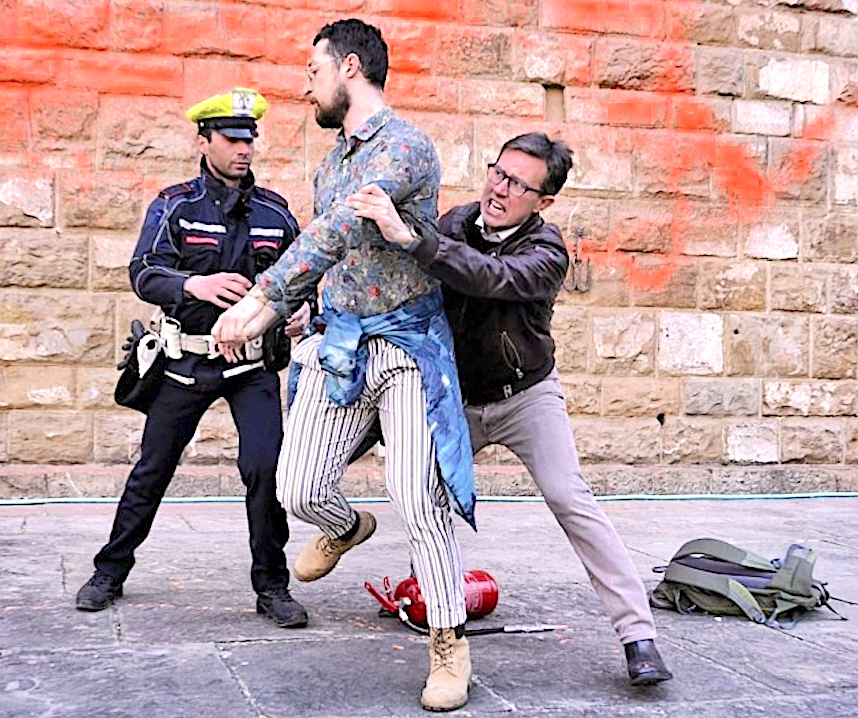
https://art-culture.world/articles/neo-eco-fascists/
Earlier on the 15th of October 2022 I proclaimed:
“As a painter I feel attacked!!! FUCK YOU “GOGH VANDALS”!
You Fucking Pussies: STOP VANDALISM on ART WORKS! #juststopoil
I hereby condemn this kind of vandalism on art works. As a painter I feel attacked and am very angry. This Gogh painting could be my painting.
Fuck you spoiled pussies! Stop this kind of shit!
Find other ways to protest.”
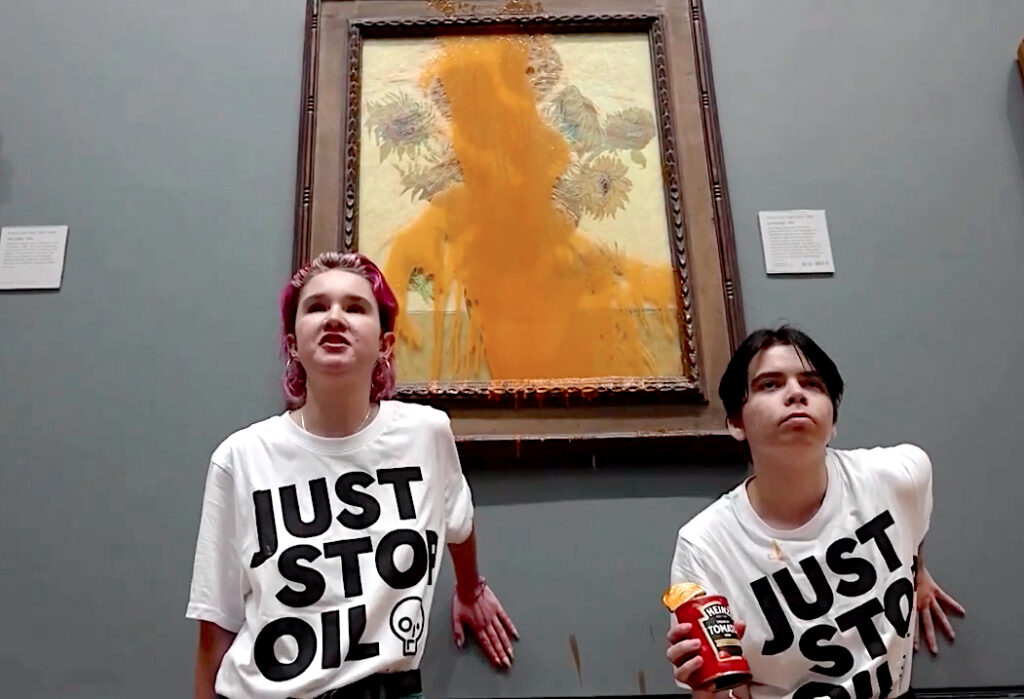
https://art-culture.world/articles/just-stop-oil-fuck-you/
up-date 2023/11/6
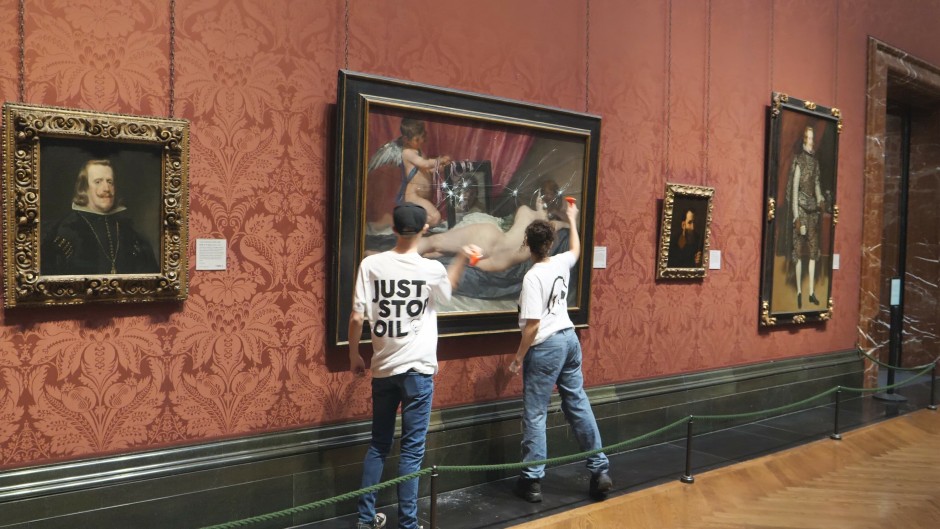
End of up-date
I may hereby politely advise Yuko, to refrain in mentioning the neo-eco-fascists, aka the “Last Generation”. I’m pretty convinced that the majority of the liberal artists, liberal curators, liberal critics and the liberal audience at the Venice Biennale won’t applaud or enthusiastically endorse you if you quote from, or act as one of, the “Last Generation”.
Which in the end, of course, doesn’t matter for an artist, who’s free in talking.
Since the Roman Empire, whole Italy knows about the problematic water situation in Venice.
Act smart.
My biggest concern regarding the execution, the installation process by Yuko in the Pavilion lies in the very poor financial endorsement by the Japanese government, the Japanese People.
The Japan Foundation, under the jurisdiction of the Ministry of Foreign Affairs, is in charge of everything concerning the Japan Pavilion.
2005. We do remember Commissioner KASAHARA Michiko 笠原美智子 begging the Ishibashi Foundation (Bridgestone) for more money that she needed for the installation of ISHIUCHI Miyako’s 石内都 works.
2015. We also remember that SHIOTA Chiharu received only 300.000 Yen (30万円, then ca. 3.000 US$) as a salary from the Japan Foundation, plus the lack of money during Shiota’s installation process.
Then you shake your head, as you see Japanese curators who don’t communicate with their chosen artist. Check the cases of SHIGA Lieko 志賀理江子 or ARAKI Nobuyoshi 荒木経惟, who both refused.
Extremely stressful and scandalous circumstances for us (poor) artists.
We wonder about the lack of professionalism by persons who are getting a salary in the Japanese art industry.
2023. The press conference photograph, courtesy Tokyo Art Beat, at the Japan Foundation shows the key-persons involved for the next Venice Biennale.

From left: TSUKA Hiroko 柄博子 (Director of the International Exchange Fund, Japan Foundation 国際交流基金 理事), LEE Sook-Kyung (Senior Curator of International Art at Tate Modern, Artistic Director of the 14th Gwangju Biennale), artist MOHRI Yuko, TATEHATA Akira 建畠晢 (Chairman of the International Exhibition Business Committee, Japan Foundation 国際展事業委員会委員長, Director of The Museum of Modern Art, Saitama 埼玉県立近代美術館館長)
Japan Pavilion at the 60th International Art Exhibition, La Biennale di Venezia in 2024
https://www.jpf.go.jp/e/project/culture/exhibit/international/venezia-biennale/art/60/index.html
Japan Foundation Annual Report 2021-2022
https://www.jpf.go.jp/e/about/result/ar/2021/pdf/dl/ar2021e.pdf
TATEHATA Akira 建畠晢:
This is my exhibition, so don’t say anything at all
「この展覧会は僕の展覧会だから一切発言しないでくれ」
The following quotes from TATEHATA Akira 建畠晢 (Chairman of the International Exhibition Business Committee, Japan Foundation) are typical for the situation in the Japanese art world.
I rewrote the coming sentences several times.
For obvious reasons.
Living, loving, working, practicing art since about 40 years in Japan, I may say that in principal nothing really changed.
I honestly would like to hesitate in writing down the following sentences, as this Japanese art scene can be analysed as a very small community, fragile eco-system, with no space to breath freely. Watching and being watched. Everybody takes care of each other, trying not to offend the counterpart, most importantly: I bow, you bow, she bows, he bows, they bow, – ergo, we all permanently bow, every day.
We have to bow in front of the Emperor Tenno 天皇.
We have to bow in front of each Imperial Family Member.
Every Japanese art dealer likes when the artist bows in front of her / him.
Seniority principle in the Japanese art world. Teacher, Maestra, Maestro, … “everyone” wants to be called “Sensei” 先生.
Capisci? You have to know your social “status” and act appropriately.
The working positions for real curators do exist, but are obstructed by OBs, Amakudari Ossans.
OB = Old Boys
Amakudari = Amakudari (天下り, amakudari, “descent from heaven”) is the institutionalized practice where Japanese senior bureaucrats retire to high-profile positions in the private and public sectors. The practice was increasingly viewed as corrupt and a drag on unfastening the ties between private sector and state which prevent economic and political reforms.
In April 2007, a law to phase out amakudari prohibits ministries from attempting to place bureaucrats in industry with implementation in 2009. However, the law also removed a two-year ban that prevented retiring officials from taking jobs with companies with which they had official dealings during the five years before retirement.
Ossan = おっさん オッサン stubborn, middle-aged or old Japanese man with bad social behaviour; seen from outside: incompetent, dumb, backward.
Check:
にっぽんの典型的、超ダサい、時代遅れのおっさんたち:荒井総理大臣秘書官 (55) の場合
Typical, Super Dumb, Outdated Old Men in Japan: The Case of Prime Minister’s Secretary ARAI Masayoshi (55)
https://art-culture.world/articles/japan-prime-minister-secretary/
美術館の館長たちへ、1日も早く、目を覚ませ! Japanese museum directors, quickly, wake up!
https://art-culture.world/articles/japanese-museum-directors-quickly-wake-up/
Non ho nessun rapporto con egregio signore Ossan Tatehata おっさん建畠. Therefore: enough is enough, Ossan Tatehata.
With 76 you should retire and give your posts to the younger generations of (Japanese) curators.
We artists dislike to see these kind of persons as typical Japanese work animals. You should retire with 65.
Work 32,5 hours per week, like in Germany, and take 4 weeks vacations. Like every person in a civilised country.
In the context of the Japan Pavilion, let me introduce you a typical situation, how arrogant Ossan Tatehata おっさん建畠 is mocking about artist KUSAMA Yayoi 草間彌生.
TATEHATA Akira:… There was a lot of criticism of this plan, and I often heard people say that if I was going to do Kusama, I should go with Kitsch, postmodern Kitsch. Some said that the entire room should be covered in polka dots, and that it should be fully displayed. But I decided to go orthodox. My idea was to introduce KUSAMA Yayoi at a turning point in the history of art. I was absolutely determined to show the net painting and penis furnishings I mentioned earlier. Fortunately, all the negotiations for the exhibition went well. But it was difficult to control Kusama. I first said to Kusama, “This is my exhibition, so don’t say anything at all” (Tatehata laughs).
IKEGAMI: What did Kusama say when she heard that?
TATEHATA: Kusama said, “hmm”. She was thinking about it because I told her that I was going to select her as a representative for the Venice Biennale. But I formed a tight besiegement around her, together with my assistants TAKAKURA Isao and OTA Hidenori, from Fuji Television Gallery. So we persuaded her, and I chose the works as I wished.
Even so, it was a difficult task. They kept trying to add more and more works by Kusama. I had no choice but to take them to the venue and persuade them not to hang them (Tatehata laughs). There are many episodes, but for my part, I think I put on an ideal exhibition. However, I still feel that Kusama’s reputation in Japan is still like that of a pumpkin lady. I installed that pumpkin section, however, the other 2/3 became a different context of the exhibition.
There was some criticism, but I didn’t look to the right or left, and I went with the orthodox approach. But my exhibition didn’t win any awards. Everyone was talking about it, but I heard later that one female juror was against it.
I told Kusama, “It was well received, so it was a great success,” but she seemed to be disappointed. I said, “It doesn’t matter if you win an award. Do you know who won the last award, Kusama-san? I don’t know anyone. When Rauschenberg and MUNAKATA Shiko won the awards, they were very influential, but nowadays, everyone forgets about the awards after a month. But after I saw Kusama again the next day, she asked, “Why didn’t I win an award?” (Tatehata laughing)
建畠晢:…この方針には批判が多くて、草間さんをやるんだったら、キッチュ、ポストモダン・キッチュでいけという意見をよく聞きました。あの部屋を全部水玉にして、全面的に展開させるべきだよという声もあった。しかし僕はとにかくオーソドックスにいこうと思ったのです。美術史のなかでのターニング・ポイントの草間彌生を紹介するという考えが全面的にあった。さっき言ったネット・ペインティングとペニスのファーニチャーは絶対出そうと思った。幸いなことに、全部出品交渉がうまくいった。でも、草間さんをコントロールするのが大変だった。草間さんに最初に「この展覧会は僕の展覧会だから一切発言しないでくれ」って言ったのよ(笑)。
池上:それを聞いた草間さんはどう言われたんですか。
建畠:草間さんは、「うーん」って言っていた。ヴェネチア・ビエンナーレの代表に選ぶということから言ったから、考え込んでいたね。でも、アシスタントの高倉(功)くんとか、フジテレビにいた大田(秀則)くんと包囲網を作って説得して、思うように選んだんですよ。それでも大変だったけどね。どんどん作品を増やそうとするからさ。もうしょうがないから会場まで持っていって、これは掛けないほうがいいでしょうと言って説得した(笑)。いろんなエピソードがありますけど、僕としては理想的な形の展覧会をやったつもりです。ただ、日本での評価はカボチャのおばさんみたいな感じが今もありますね。そういう部分も出したんだけど、そうじゃない部分を3分の2くらいにした。批判もありましたが、僕は右顧左眄しない、オーソドックスにいくということを貫いたんです。でも、これは賞が取れなかった。みんなが話題にしていたんだけども、ある女性審査員が反対したという話を後から聞きましたが。
「評判よかったから大成功ですよ」って言ったんだけど、草間さんはがっかりしたようでした。「賞なんか獲ったって、どうってことないですよ。草間さん、前回の賞を獲った人知っていますか。誰も知らないですよ。ラウシェンバーグとか棟方志功が獲ったときは影響力があったけども、今は賞なんて1ヶ月もしたらみんな忘れてしまいますよ」って言ったら、「そうね」って言う。だけど、また次の日に会ったら、「何で賞とれなかったの」って(笑)。
https://oralarthistory.org/archives/tatehata_akira/print_02.php
LEE Sook-Kyung 이숙경 had been met with much applause from the local Japanese art scene. This was preceded by Lee’s invitation of Yuko for the ongoing Gwangju Biennale. The complexity of the Japan Pavilion’s curatorial practice has finally been given an important additional level.
The selection of those involved should not be narrowly focused on artists and curators with a Japanese passport.
In principal it’s a fact that Japanese curators do not choose me because I do not possess a Japanese Passport. (You can imagine the consequences, as I would like to show my works in the Japan Pavilion, a.o.)
Already in 2013, when Tokyo’s gallery AOYAMA MEGURO’s artist TANAKA Koki 田中功起 had been awarded by the Jury of the 55th International Art Exhibition of La Biennale di Venezia with a ‘Special Mention’ (特別表彰を受賞) for the Japan Pavilion (Curator KURAYA Mika 藏屋美香) https://www.labiennale.org/en/node/2332 , France and Germany switched their pavilions.
Susanne Gaensheimer, the curator of the German pavilion showed “her” very NON German artists Ai Weiwei, Romuald Karmakar, Santu Mofokeng, Dayanita Singh in the French Pavilion. Christine Macel, curator of the French Pavilion let her artist Anri Sala play in the German Pavilion.
When I attended the Venice Biennale in 2003, I was not allowed into the Spanish Pavilion as Santiago Sierra demanded exclusively the Spanish Passport when entering the Pavilion from backside. The frontside entrance had been shut down. An excellent concept by Sierra, which initiated already 20 years ago the discussion, if we need these 29 “country-pavilions”, as they obviously don’t represent the world. In the last years, the number of “pavilions” had been stretched throughout Venice, now called “National Participations” (some 80 to 90).
Also the late, highly respected, curator Okwui Enwezor showed on multiple events like Venice or documenta that the “Passport” problem should be resolved.
When I visited last year’s (anti-Semitic) documenta, I felt that the curatorial team already went a step further by “refusing” to publish the artist’s “nationality”. The intellectual frame in Kassel had been put on the “Global South” and “Global North”, the discriminating socio-economic and political agenda contextualised through oppressive history-colonial powers. For me, coming from the Berlin University of the Arts, Free University of Berlin, and attending the events organised by the ‘Haus der Kulturen’ in the 80s, that documenta concept triggered off a long overdue, necessary discourse. As Japanese people don’t regard themselves as belonging to the “Global South”, but the “Global North”. Why do you think is that so?
In which box would you put today Saudi-Arabia, Israel, Taiwan, Singapore, South Korea or China?
Foreigners Everywhere
In this lineage of questioning the artist’s passport or nationality, the overall theme of next year’s Venice Biennale has been titled “Foreigners Everywhere”.
I quite often experienced Japanese travelling abroad who would say “Gaijin-darake” 外人だらけ. Means, everywhere you look: foreigners. Xenophobia is very pronounced in Japan.
Nota bene! In the context of the ‘lost in translation’ of “Foreigners Everywhere”, some may use the more “polite, ambiguous” Japanese translation “Ihojin-darake” 異邦人だらけ, which means “strangers everywhere“.
Curator, Museu de Arte de São Paulo artistic director, Adriano Pedrosa emphasising hereby the artists as outsiders, foreigners, and more, highlighting those who have traveled at various points in their careers.
“Today I realised how lucky I am to have been born as a Japanese. I also have a great deal of reflection on what I have done for the culture,” said actor TAKAKURA Ken at a press conference held on Culture Day 2013 to commemorate the conferral of the Order of Culture.
2013年11月21日
「日本人に生まれて本当によかったと、きょう思いました。文化のために何をしたのかなという反省も大きくあります」と今月、文化の日に文化勲章親授式の記者会見で俳優高倉健さんがこう述べました。
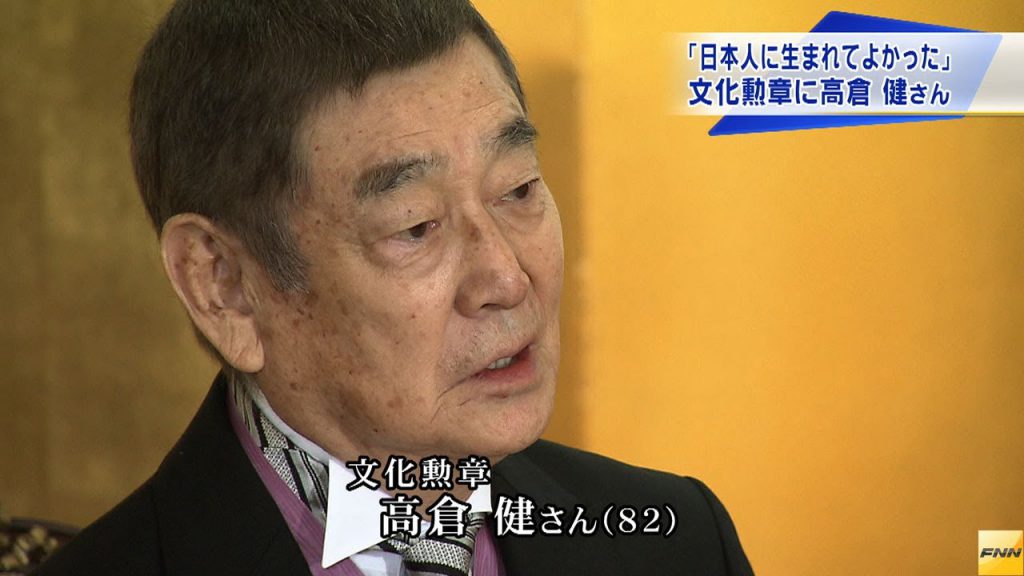
In Japan you can hear these kind of sentences quite often. Symptomatic, as the ordinary Japanese doesn’t realise, understand its xenophobic meaning and the implications on a foreigner like me.
See:
我が国にっぽんの恥「日展」”Nitten”, the Shame of our Nation Nippon
https://art-culture.world/articles/nitten-the-shame-of-our-nation-nippon/
毛利悠子 MOHRI Yuko’s work “sadly”, 2019
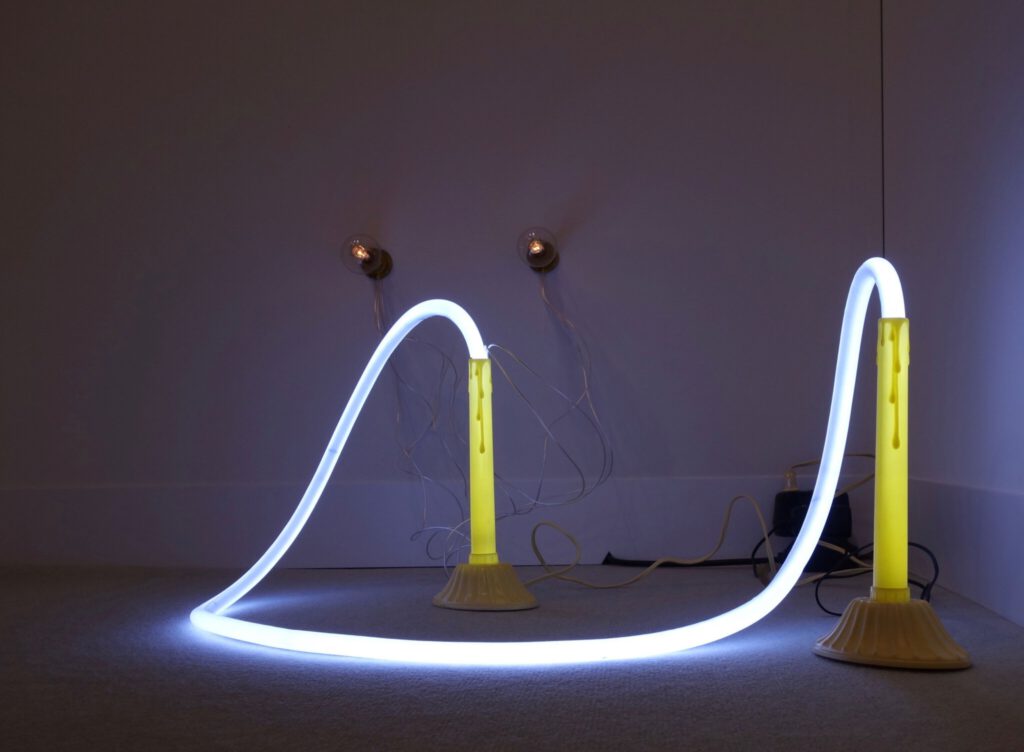
Plastic electric candlesticks, LED tube, halogen light bulb, step-down transformer, cable. Dimensions variable (As installed: 42 x 140 x 70 cm)
Yuko’s evolutionary progress with her body of work “I/O: Chamber of a Musical Composer” found its marvellous result during the group show “Roppongi Crossing 2016: My Body, Your Voice,” in the Mori Art Museum. Her kinetic work, titled “From A” (2015-2016), captured one’s poetic heart. A silent, euphonious noise coming out of the installation of an unseen dynamic magic tending to capture the attention of the audience. The autonomous moving bodies created from banalities that contain errors and fluctuations could be analysed as an exploration for ‘la condizione umana’, Yuko’s perception of her surrounding. To contemplate it was mesmerising in what I felt to generate tranquility of your soul. See my pics below…

看板、パネル、スプーン、モーター、フライパン、ベル、鏡、方位磁石、トライアングル、ボビン、カウンター、木材、扇風機、鉄道模型、楽譜クリップ、ケーブル、ワイヤー、毛ばたき、電球、リボン、電子基板など
Metal signage, panel, spoon, motor, flying pans, bell, mirror, compass, triangle, bobbin, counter, wood, fan, model signal, music score clip, cables, wires, duster, light bulb, ribbon, electric board, et al.. Size: 500 × 300 × 80 cm
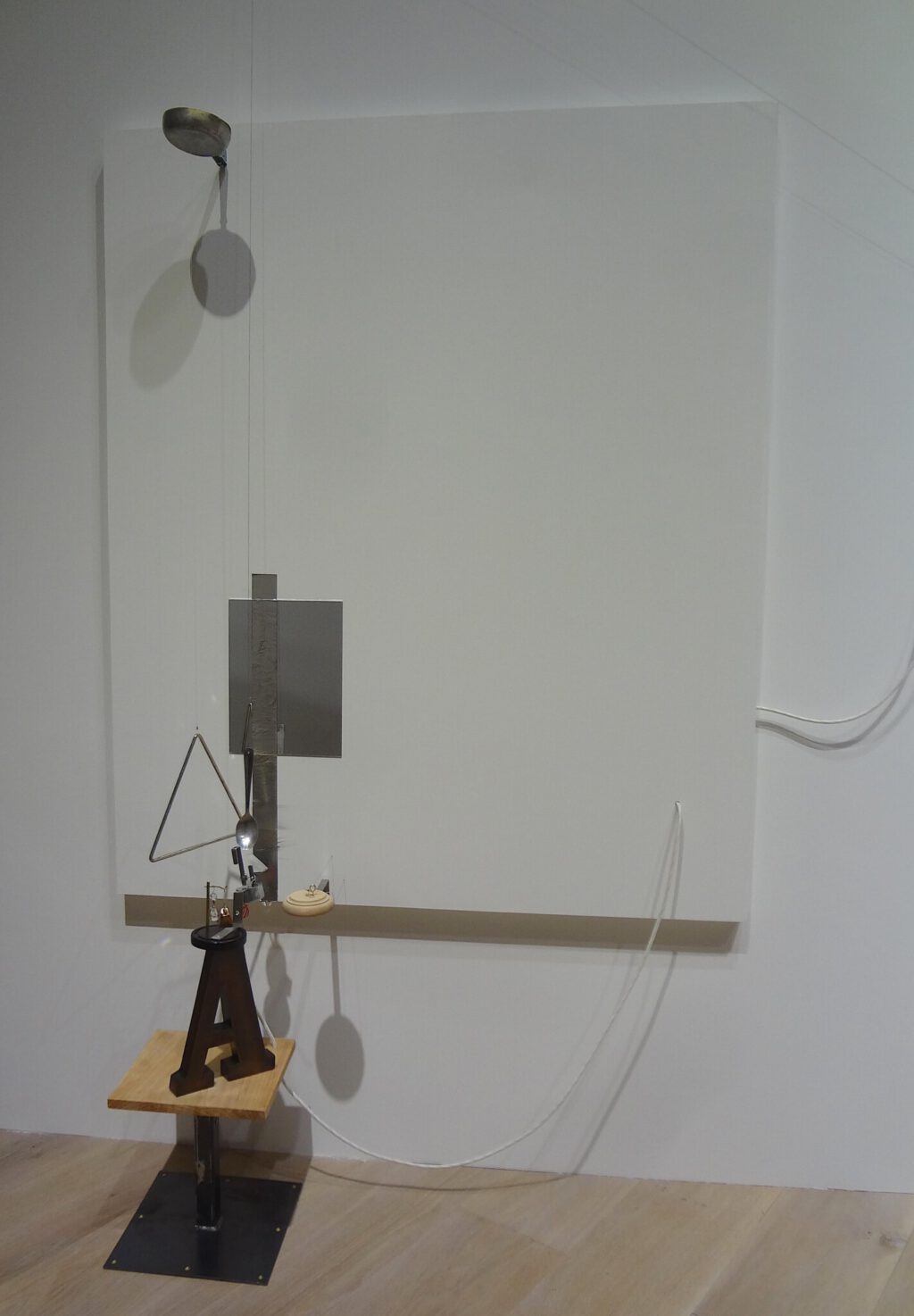
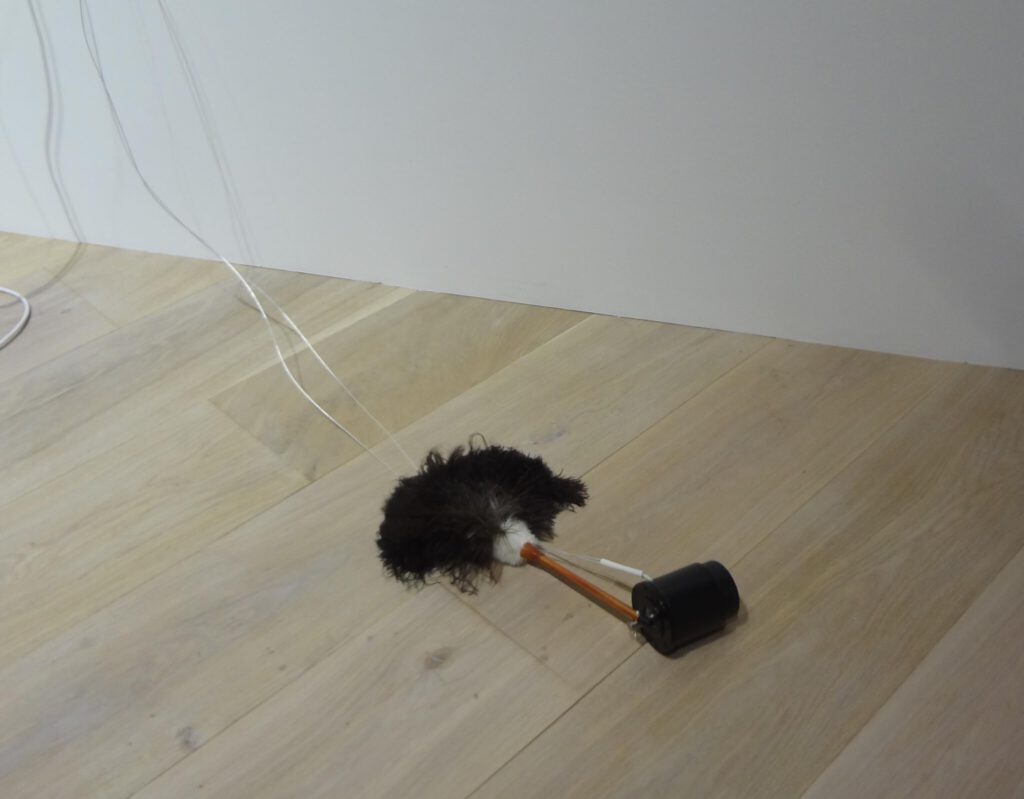

Yuko’s latest work gives us art lovers a hint, in which direction her artistic practice might develop. With “Urban Mining” 2023 @ mother’s tankstation’s booth Art Basel, I do associate not only the Sustainable Development Goals (SDGs) concept, but also the cycle of electricity generation via the recycling process in the age of post-urbanization. Unfortunately, bauxite continues to be mined in Guinea for aluminum production under disastrous, inhumane conditions. A disgrace that polluting vending machines exist on every corner in Tokyo. Shame, that unnecessary skyscrapers continue to be built in Tokyo, causing the population in congested Tokyo to continue to rise. Rents are still going up, not down. Shame on the Japanese people who voted for these irresponsible, disastrous politicians.
Said that, I recognise Yuko’s serious intention to do something about the destruction of our Mother Earth.
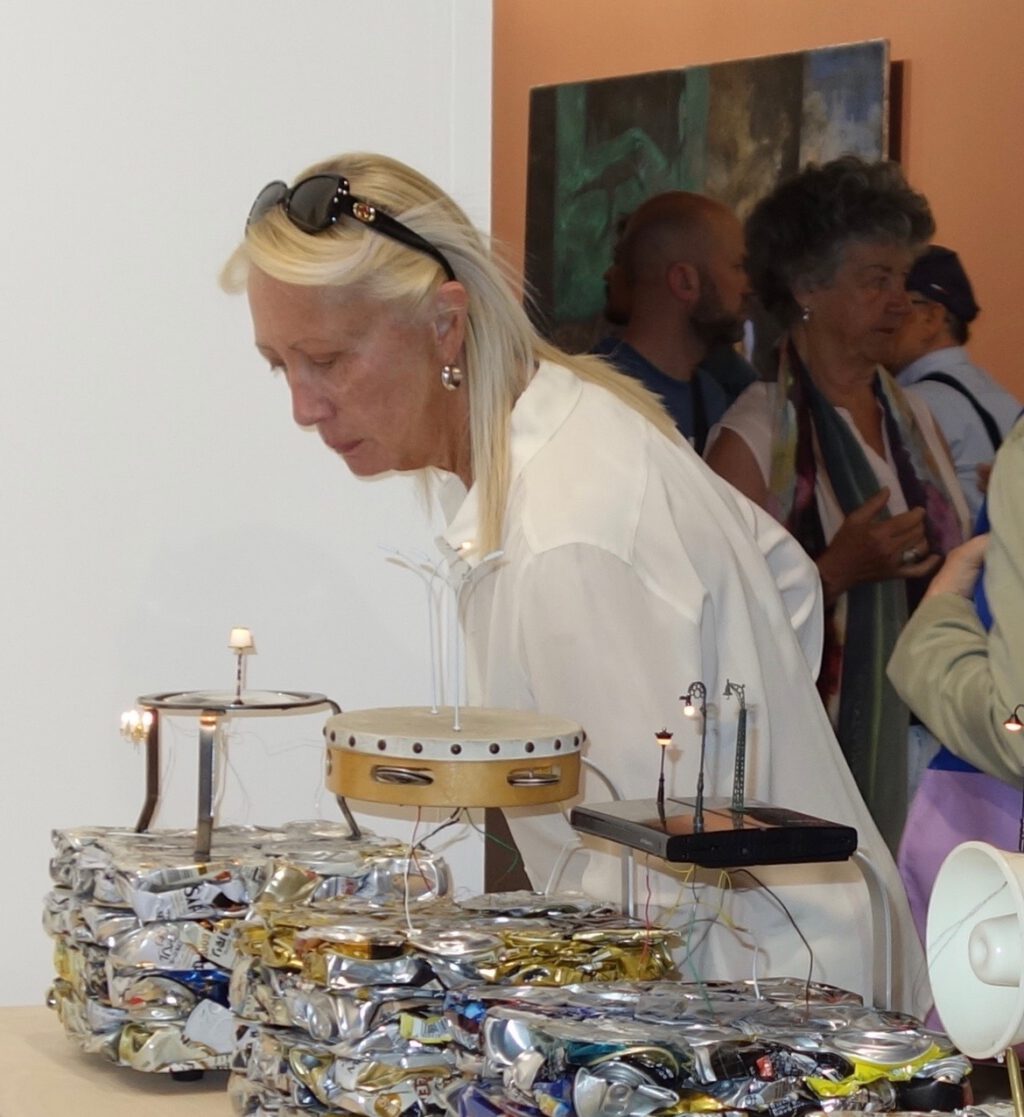

毛利悠子.
MOHRI Yuko, the artist is present.
Yuko’s social consciousness.
I hope today’s reader of ART+CULTURE could understand the universal concept of Yuko’s art practice. In the field of tension between SDGs, Jean Tinguely, Luigi Russolo and TAKEMITSU Toru exists the charming complexity for the future groups of her works. In contrast to the development of the so-called Quantitative Aesthetics, which functions for a young generation of Biennale visitors as a substitute regarding analogue contemporary art. We are all very much looking forward to the Italy Voyage. The following pics may give an idea of how difficult it is for an artist to occupy the Japan Pavilion in Venice, the obstacles to install the already prepared body of works. I personally wish that one day she will have a solo show at the Tinguely Museum, as well as a performance at the Donaueschinger Musiktage, the Festival for New Music, which is taking place near me. There where Anselm Kiefer was born.
A bright future lies ahead for Yuko, indeed. Bravissima!!!
Tokyo-Basel, 24th of June 2023
Mario A 亜 真里男
Artist’s website:
https://mohrizm.net
2023/9/9 up-date:
Yuko Mohri: Composing With Invisible Phenomena
The Tokyo-based artist tracks the fluctuations of the world around us, from dust and light to rotting fruit
IN FRIEZE SEOUL , VIDEOS | 09 SEP 23
https://www.frieze.com/article/yuko-mohri-composing-invisible-phenomena
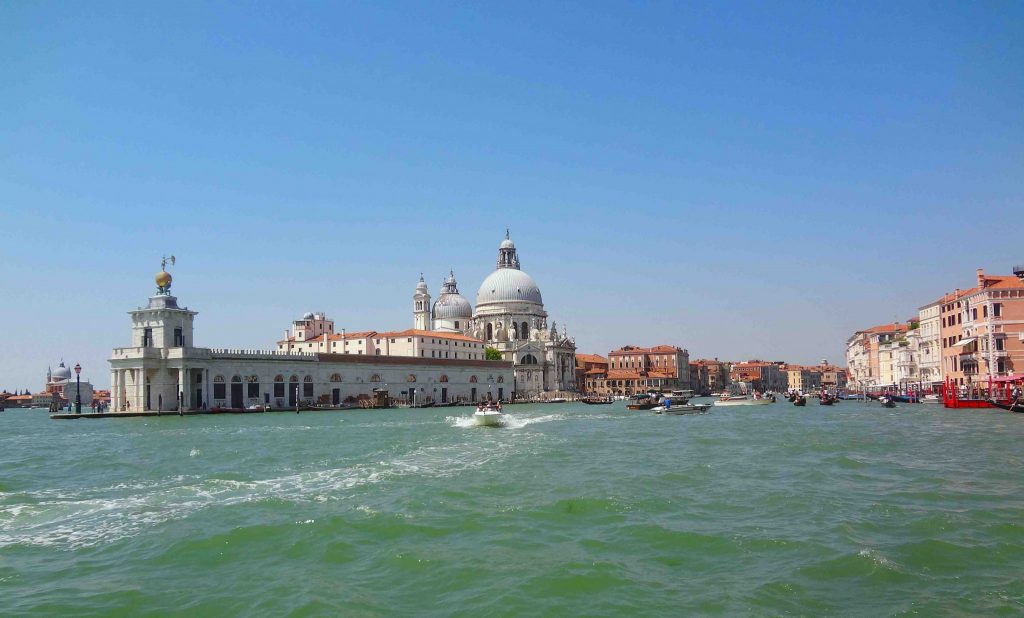

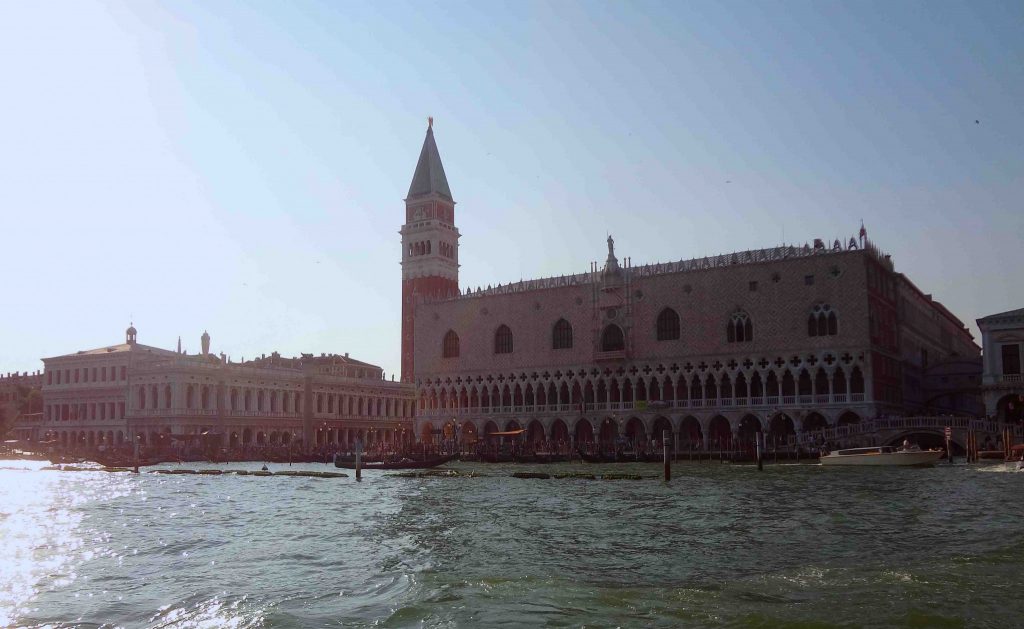

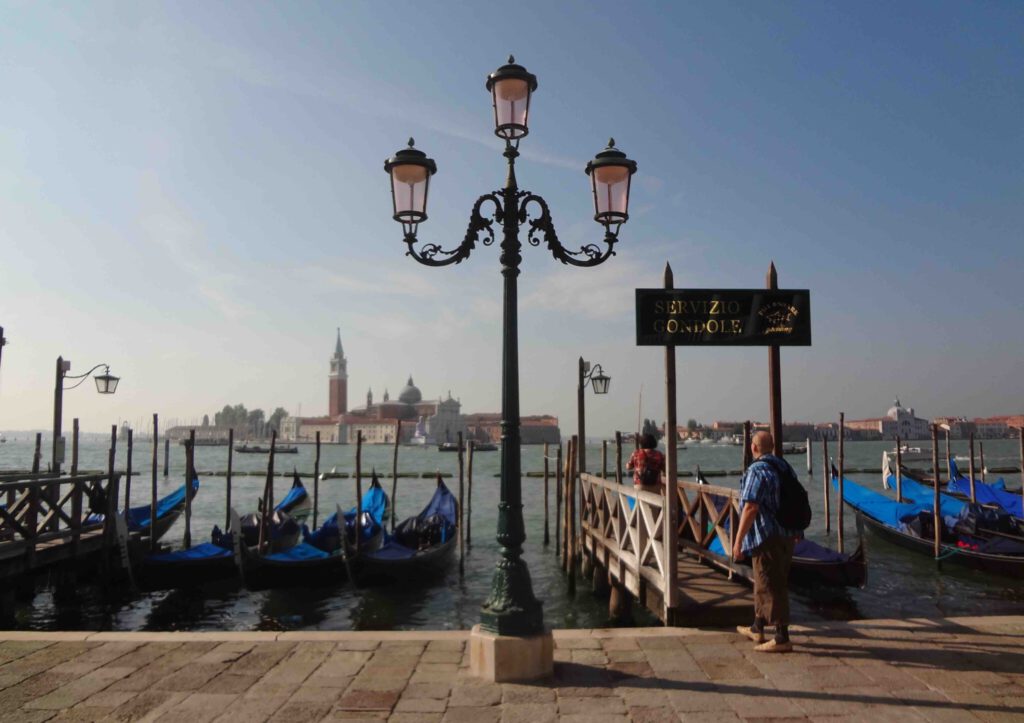

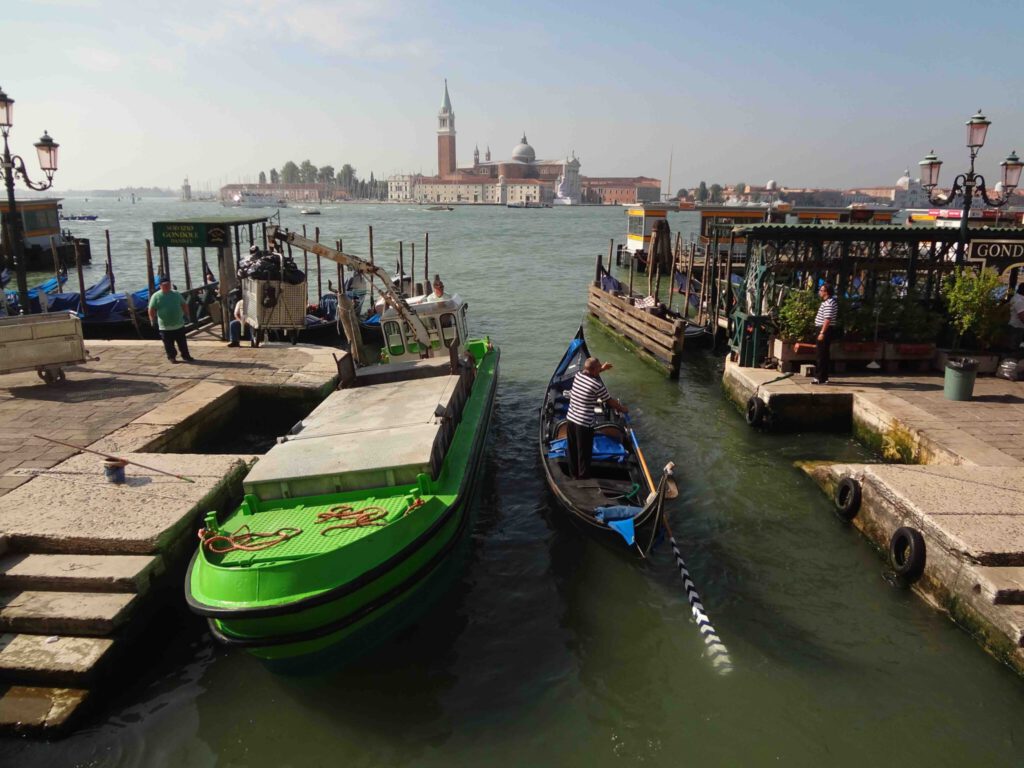

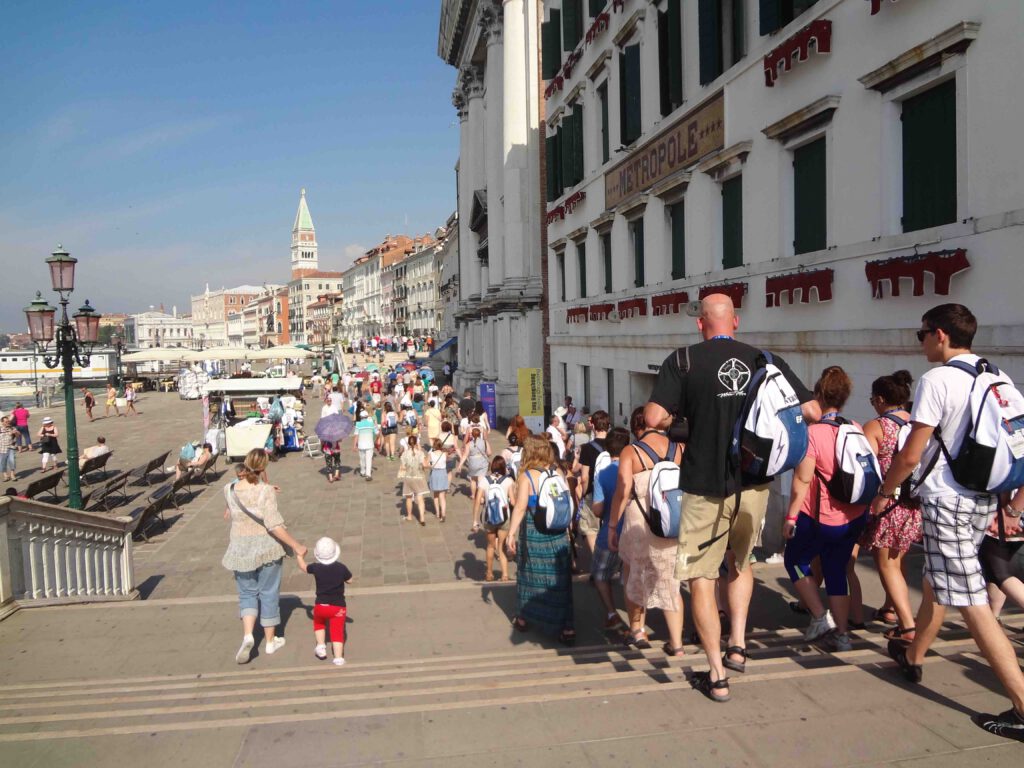


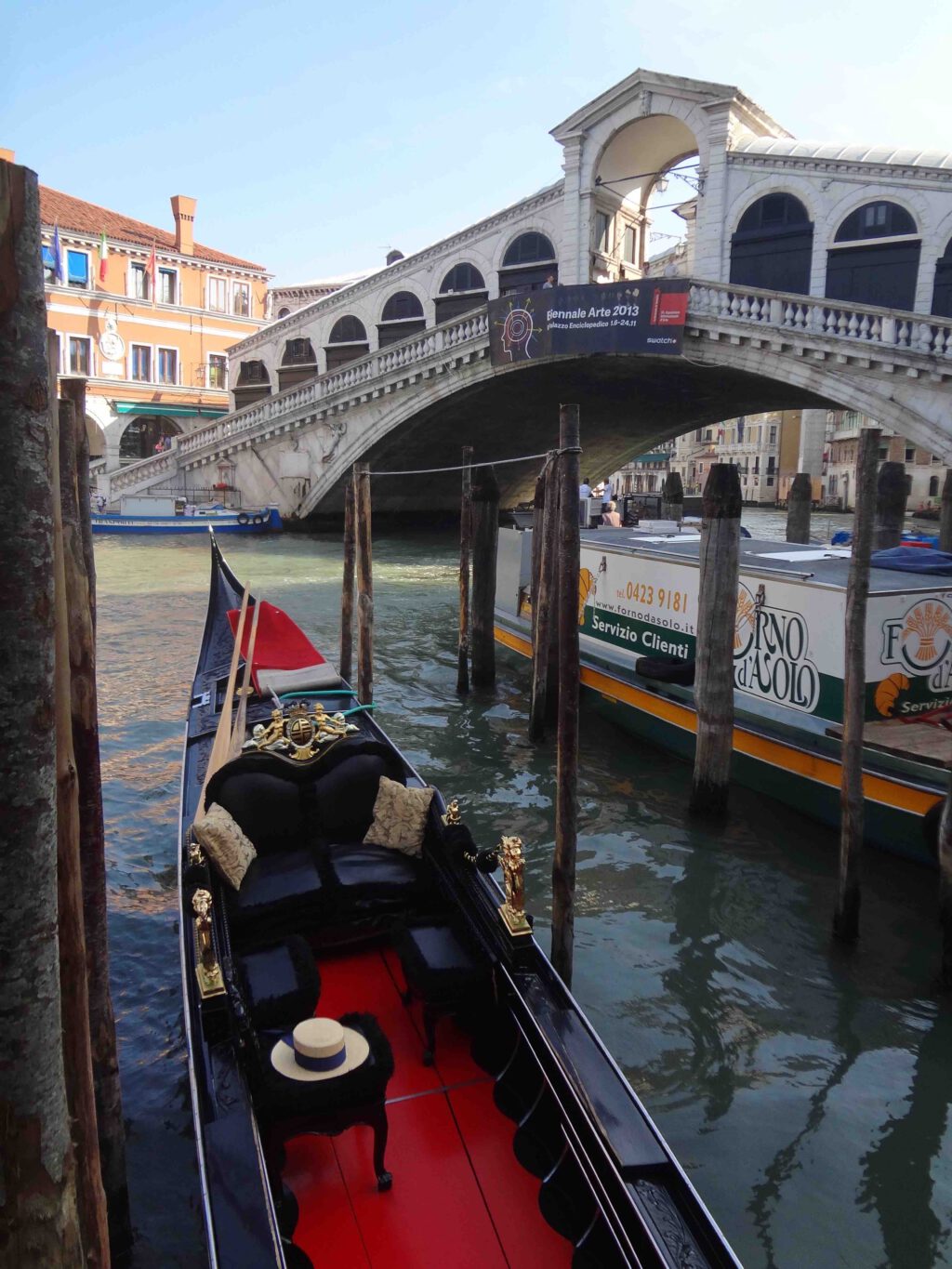
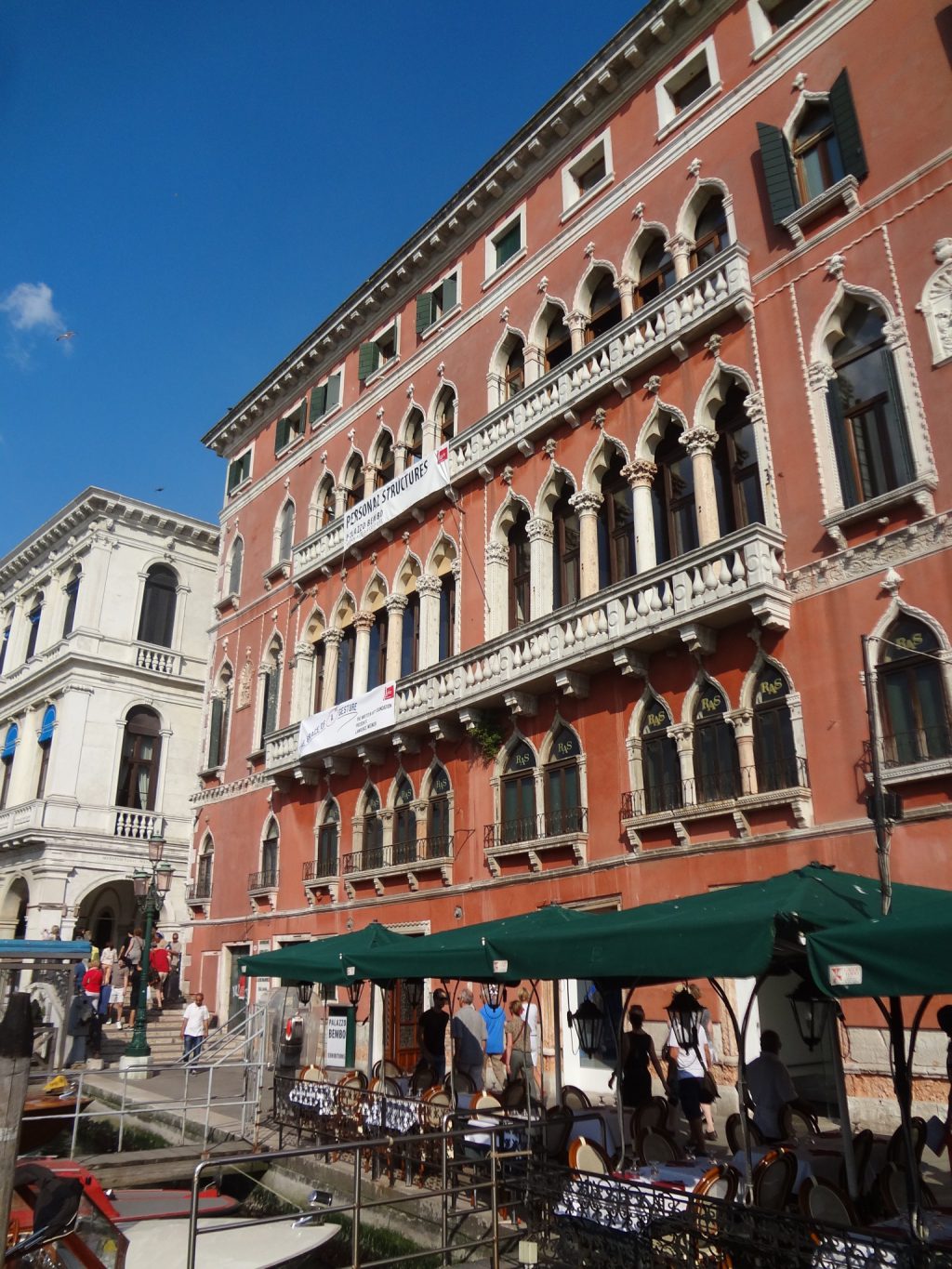

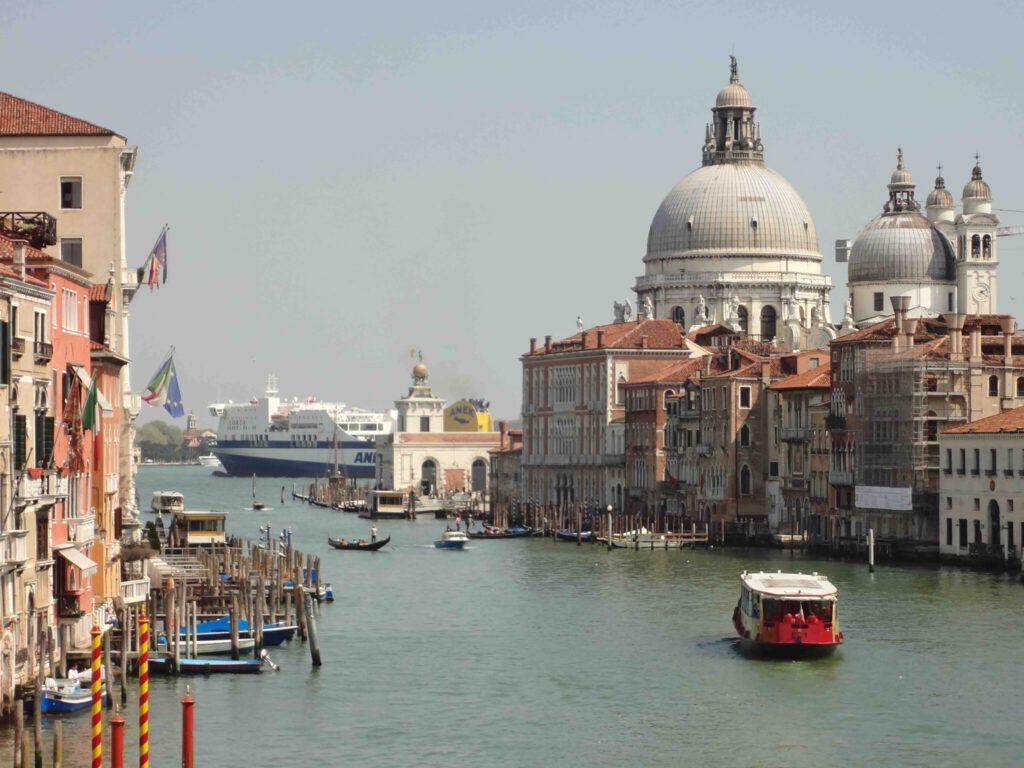
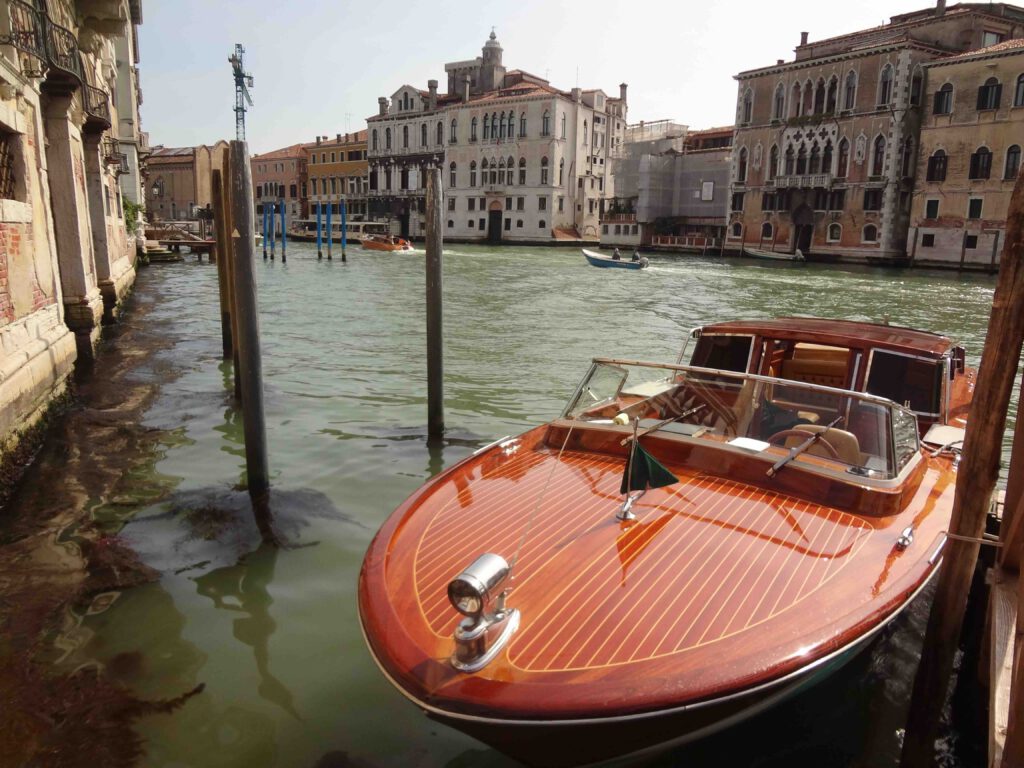
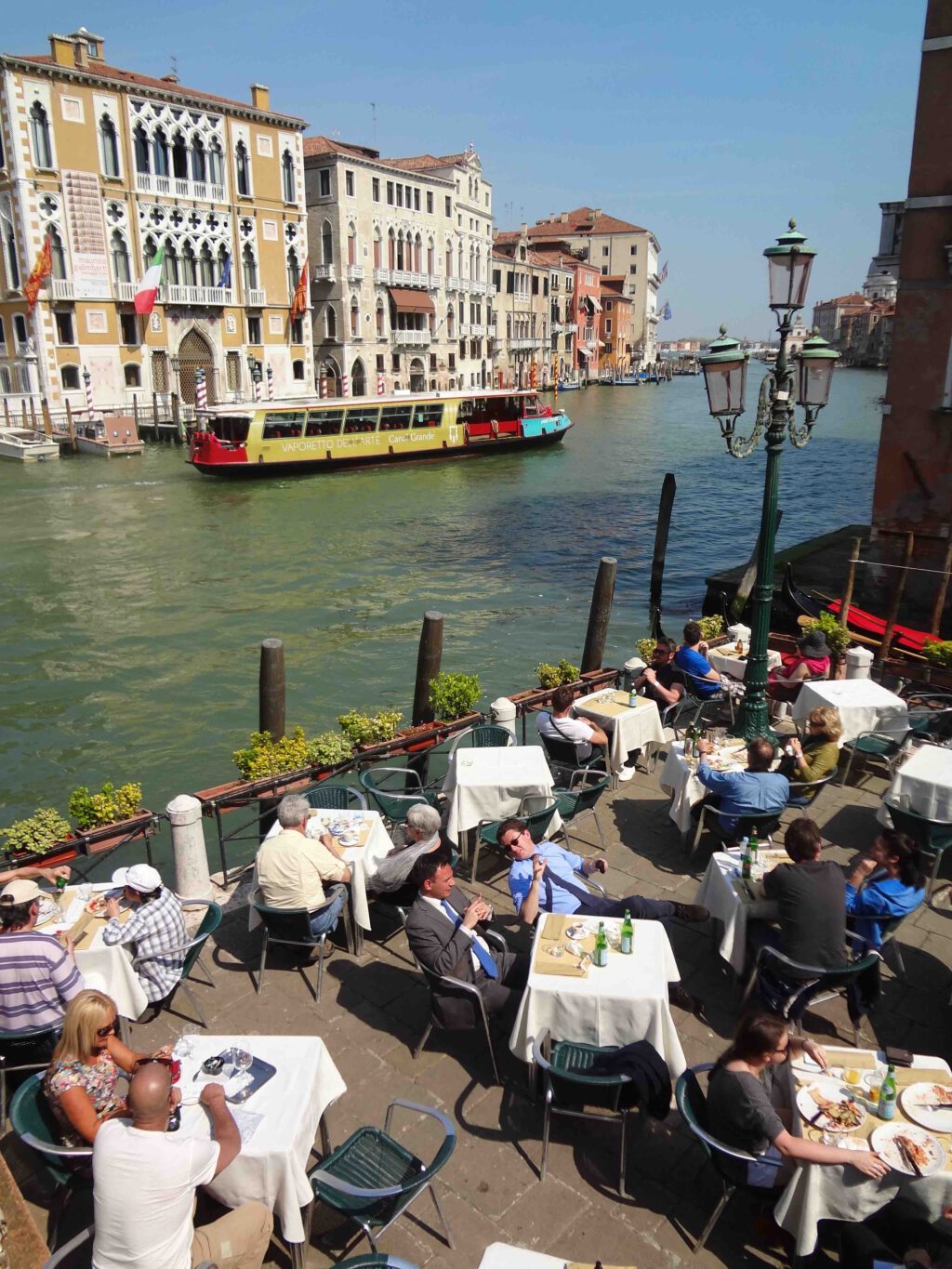
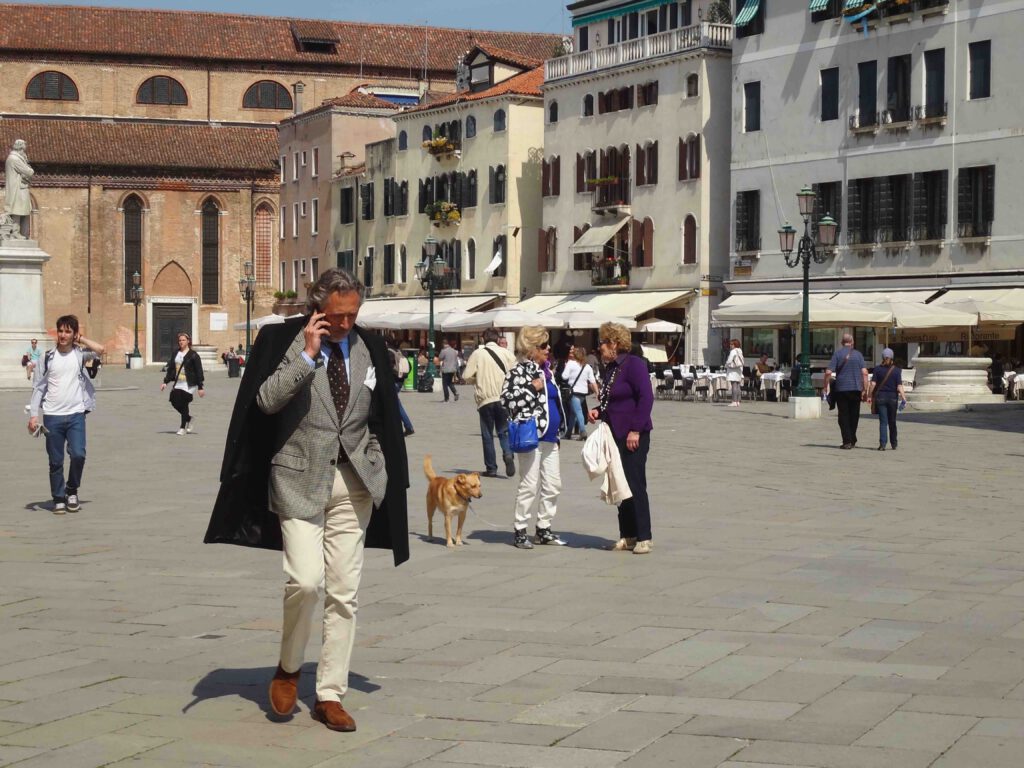
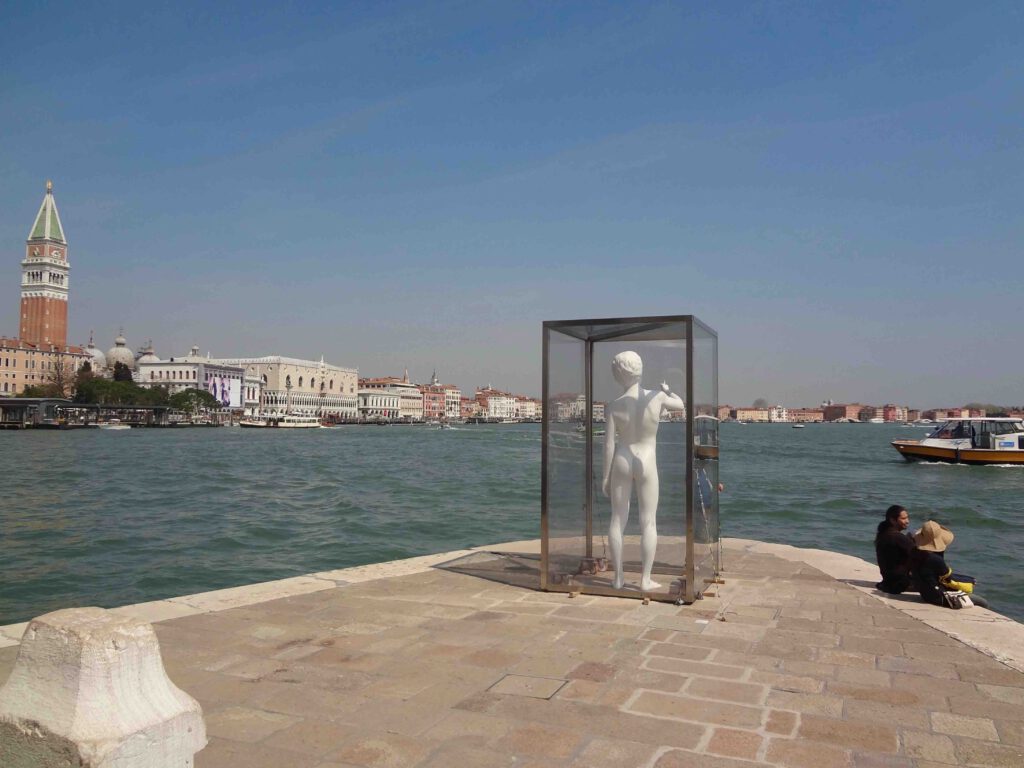
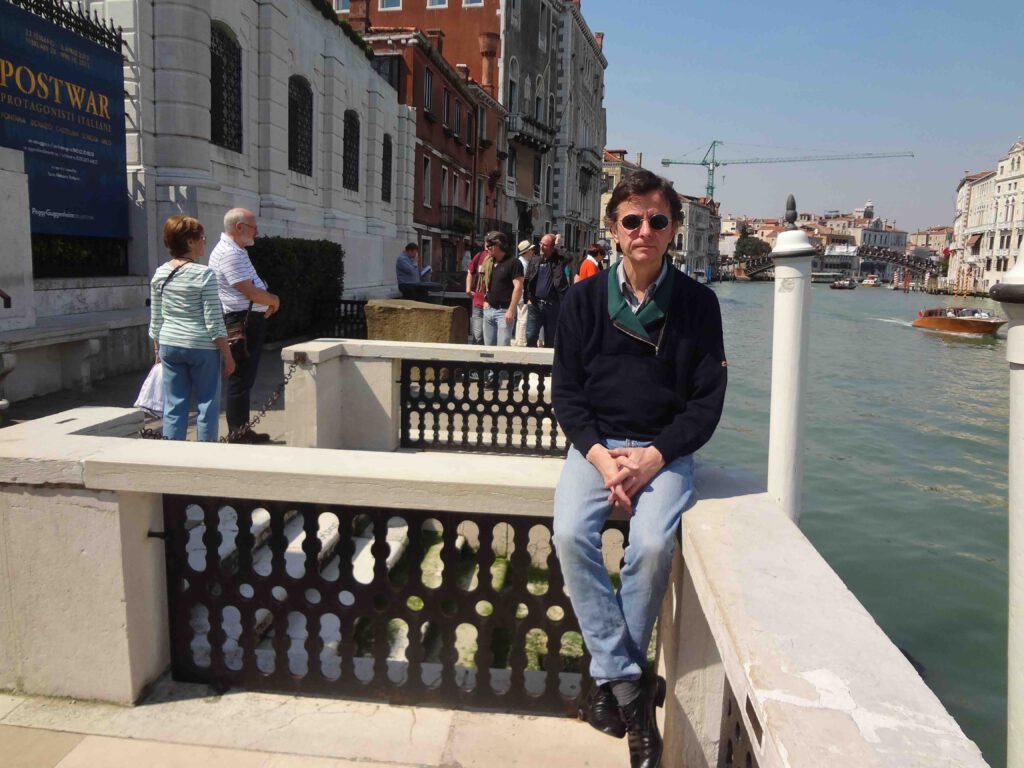


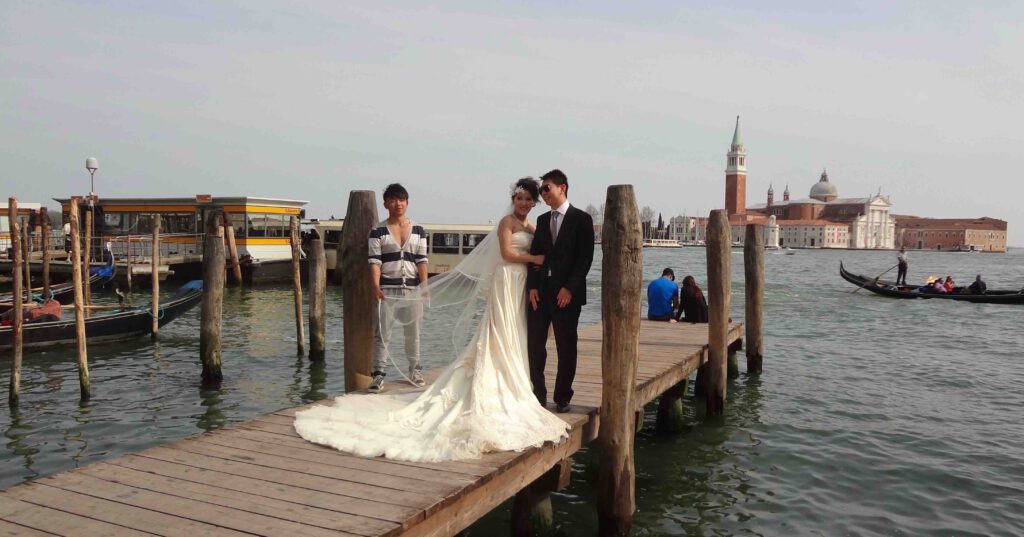

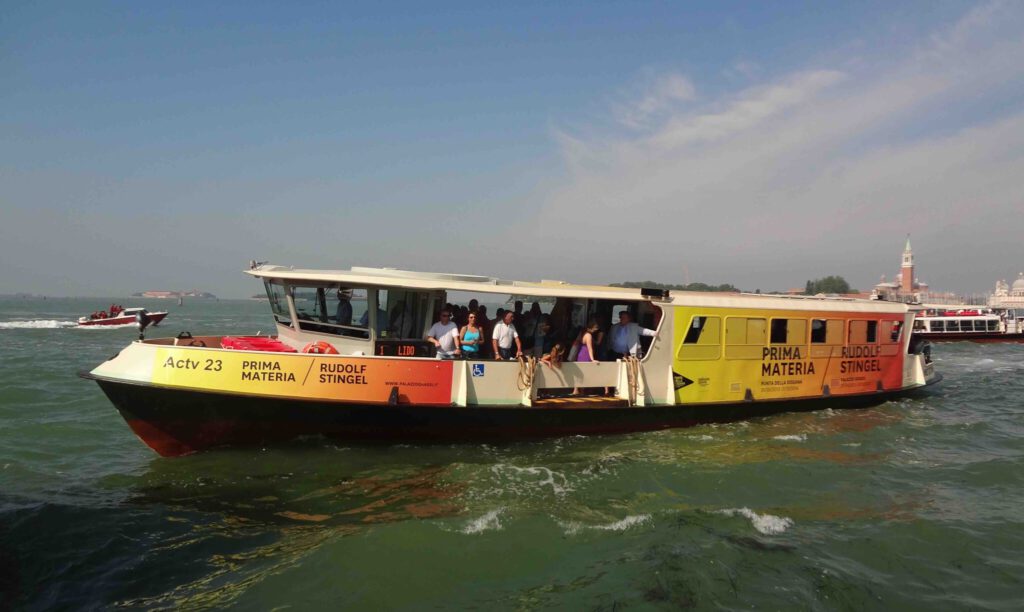
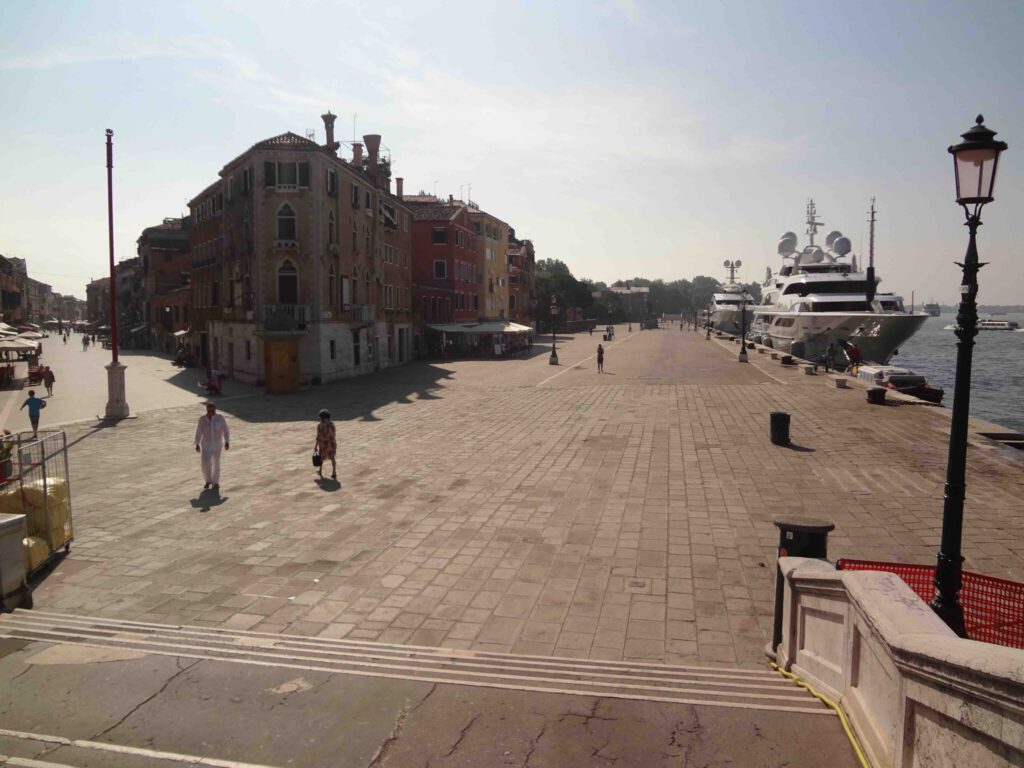

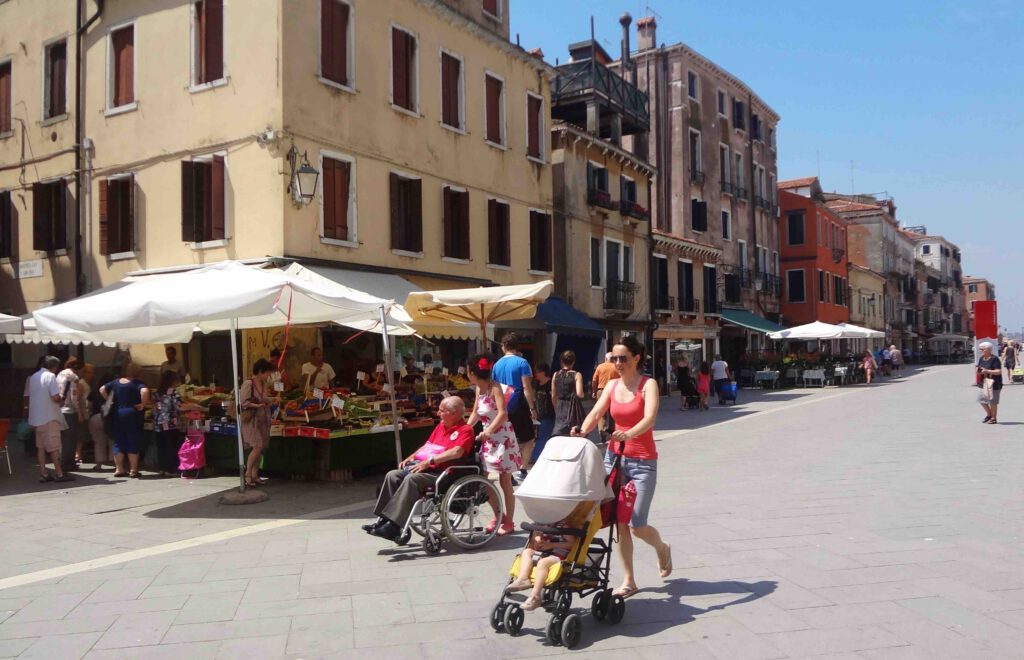
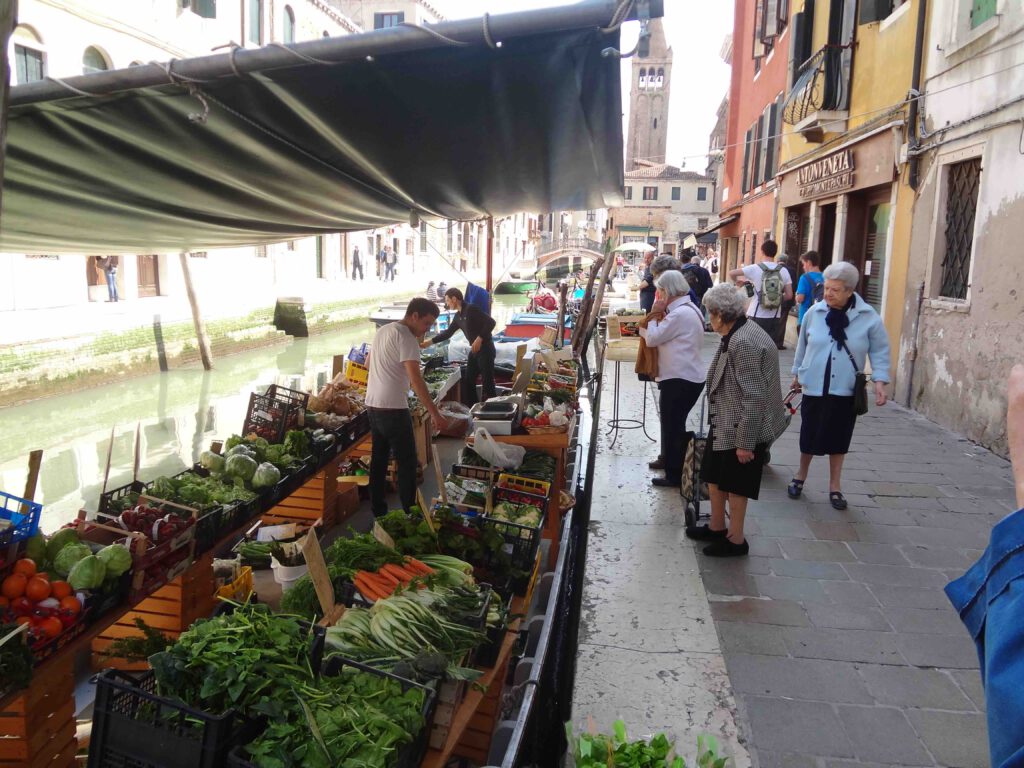
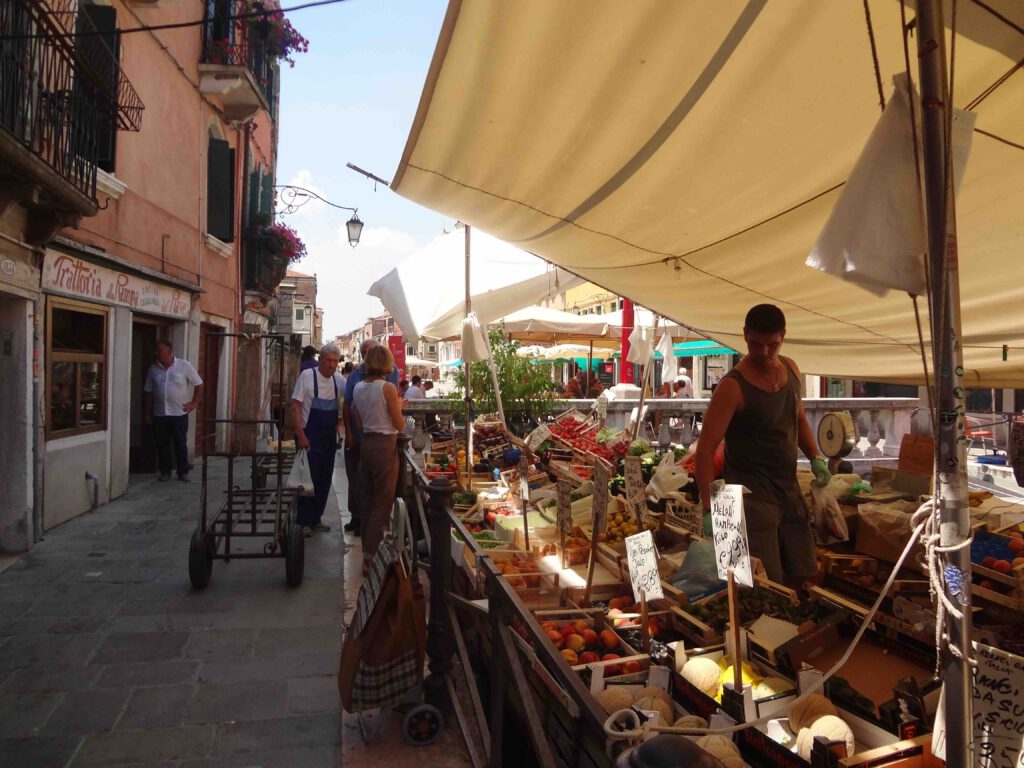
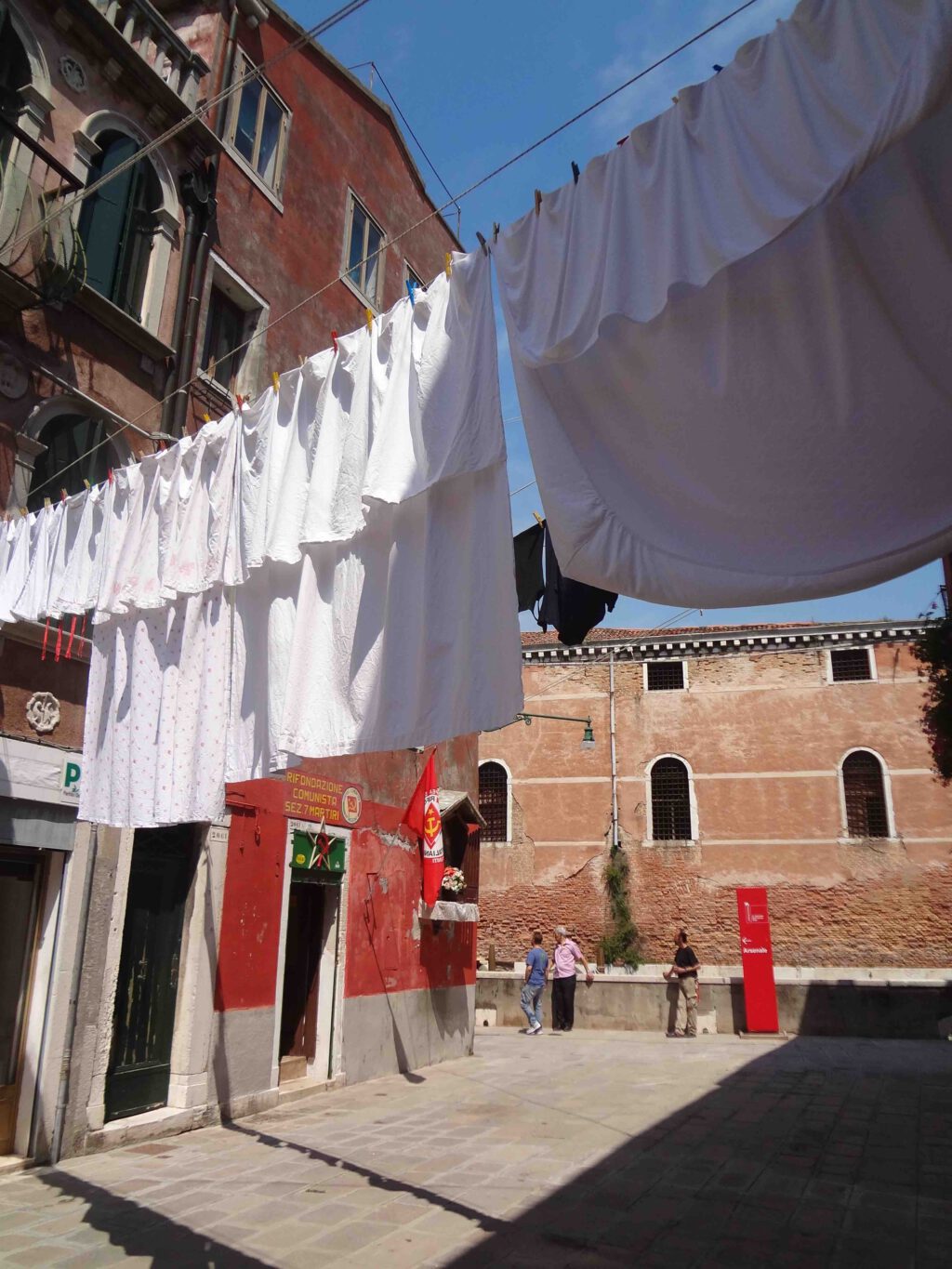

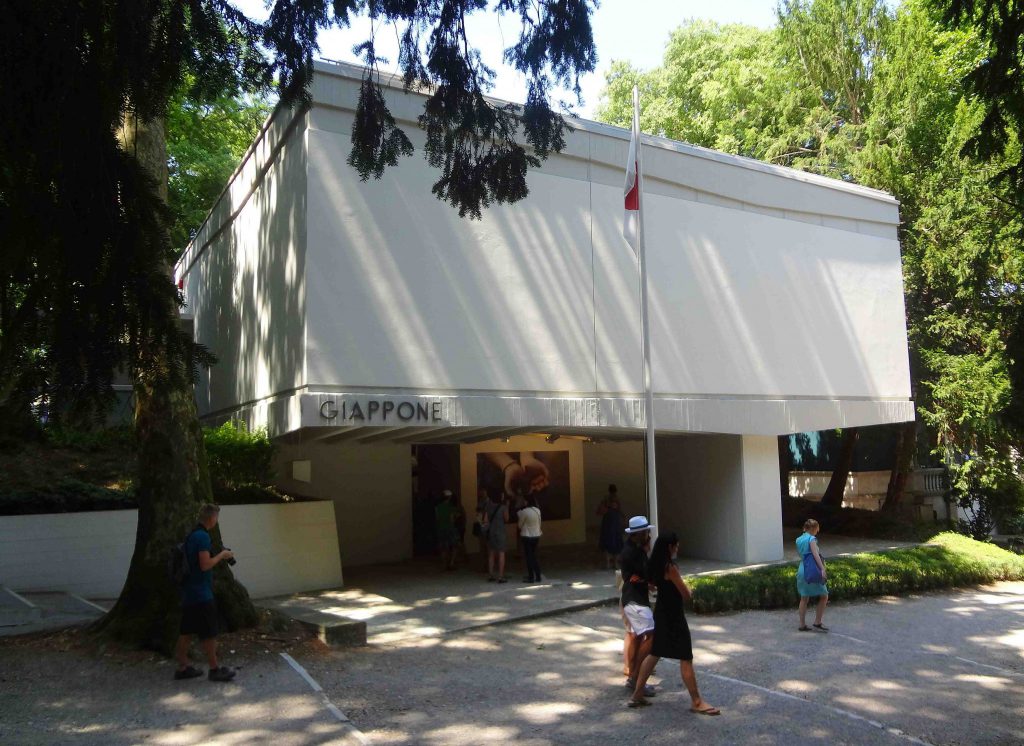
日本館 Japan Pavilion GIAPPONE(= イタリア語)Japan
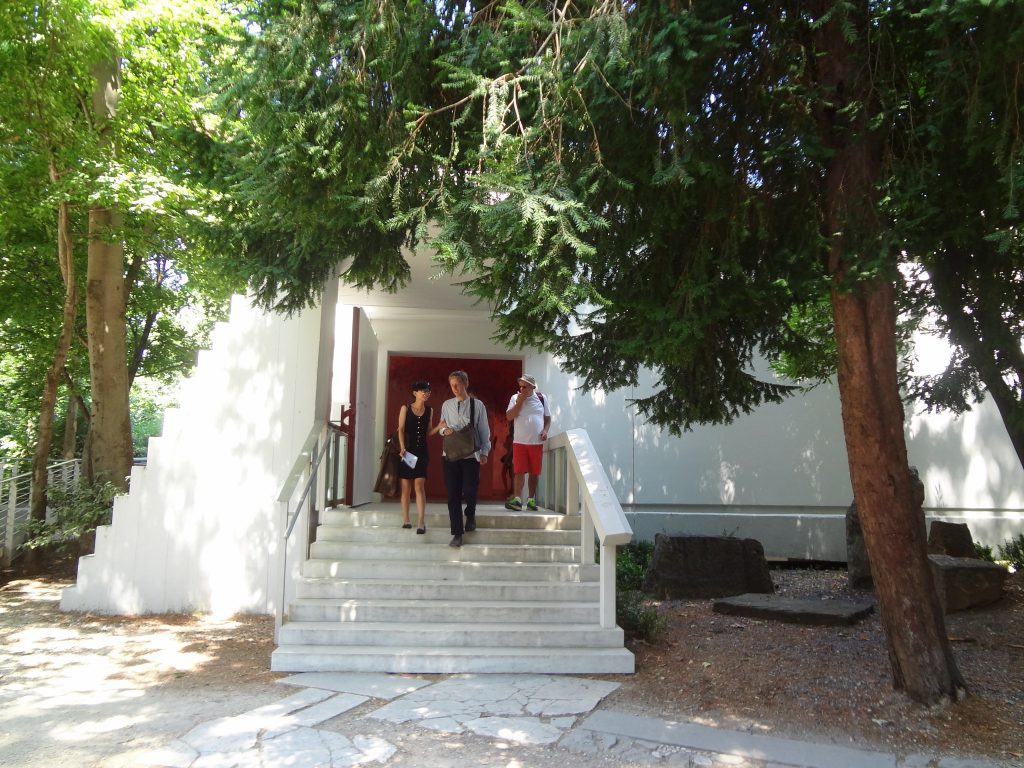
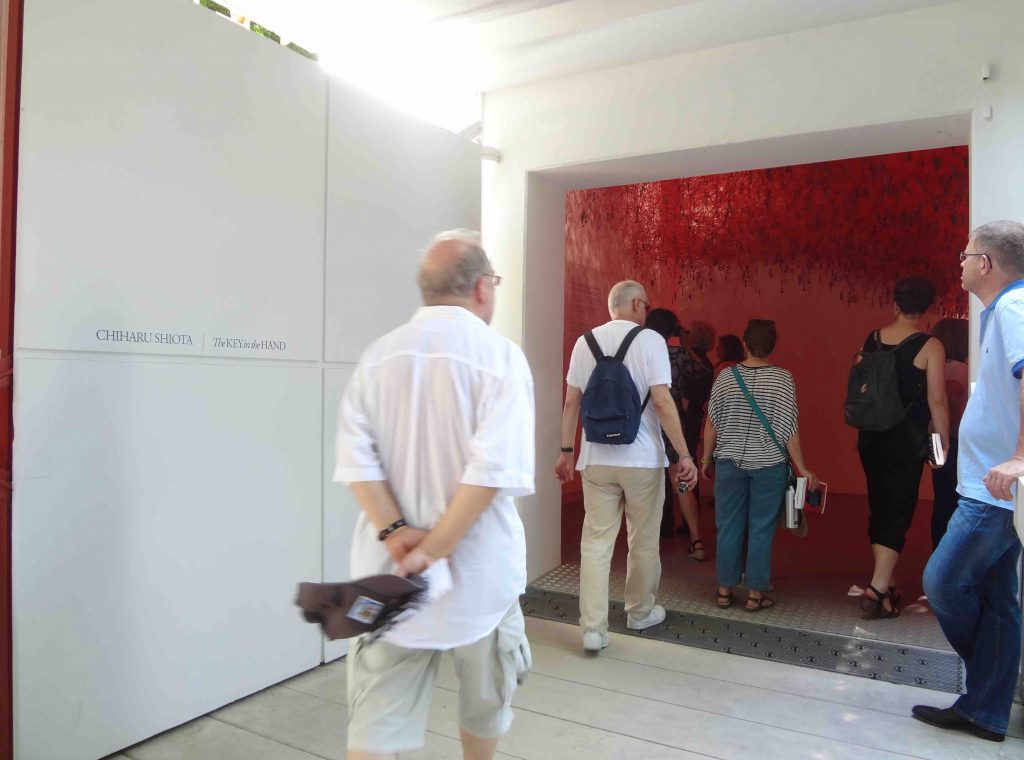
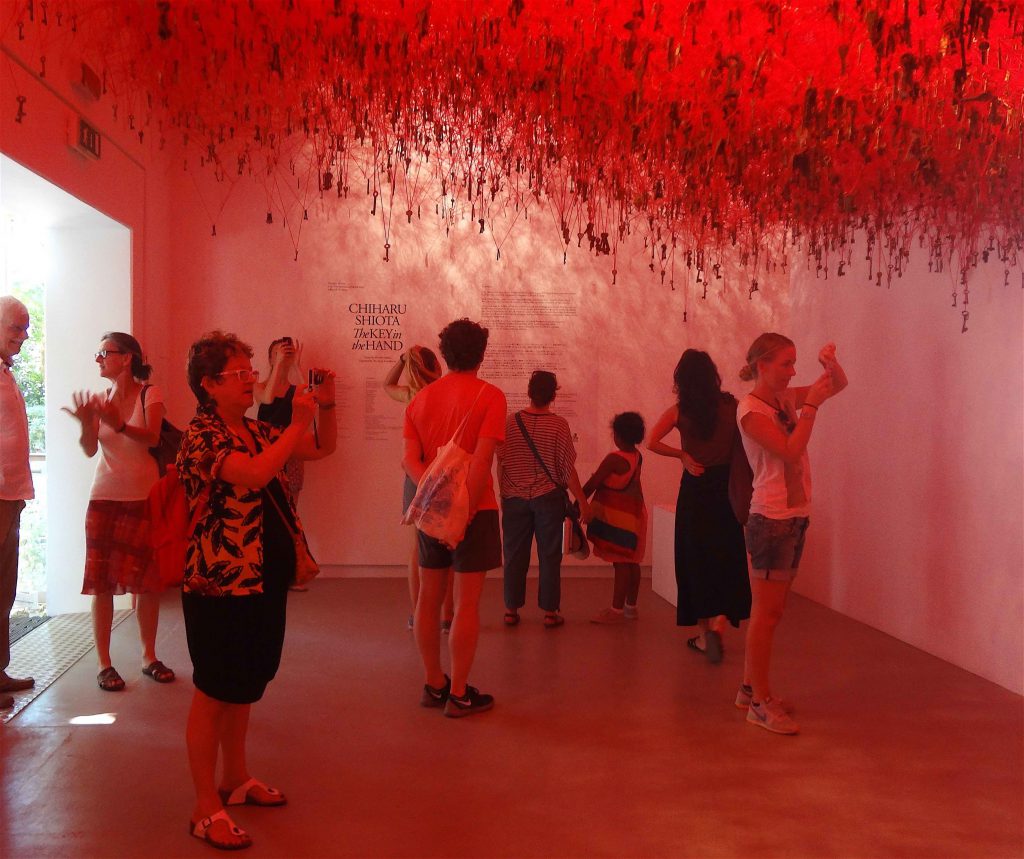

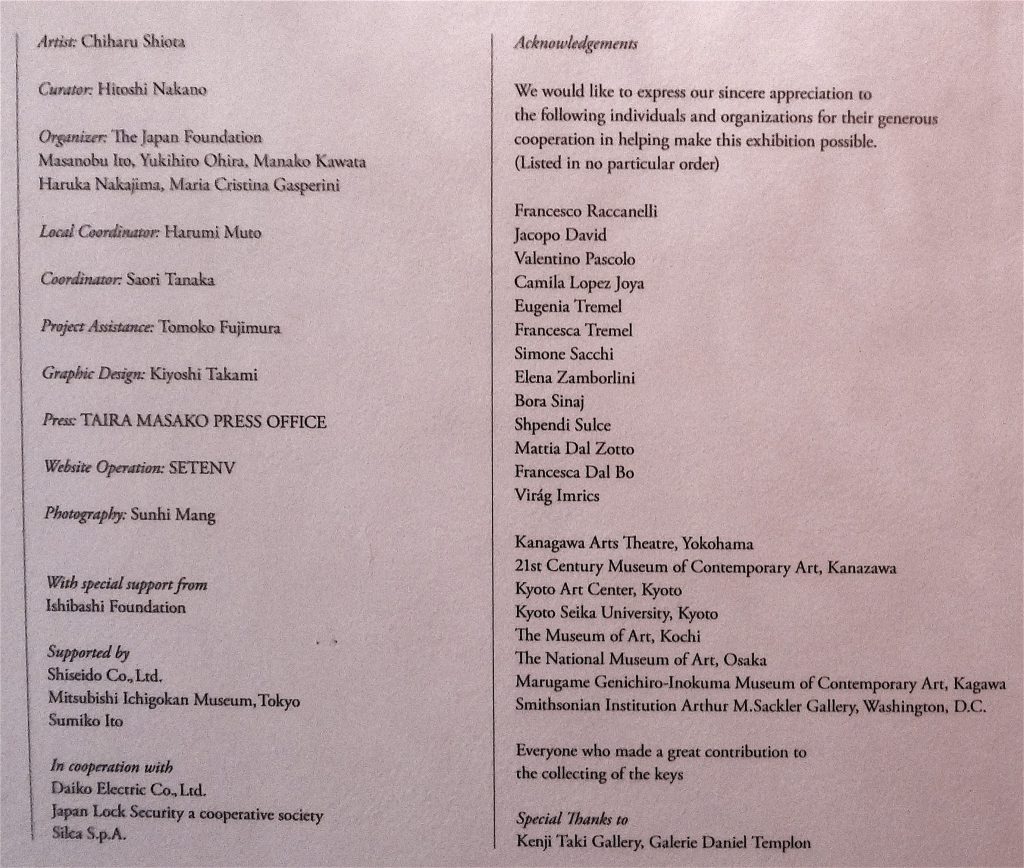
More @
塩田千春作:孤独と生命線の神秘な相関巣 (過去サイト・アーカイブの再投稿、2013年2月3日)
SHIOTA Chiharu: Mysterious Nest-specific Correlations Between Loneliness and Lifelines (repost from the archive, 2013/2/3)
https://art-culture.world/articles/shiota-chiharu-shiota-塩田千春/
日本館 Japan Pavilion 2013
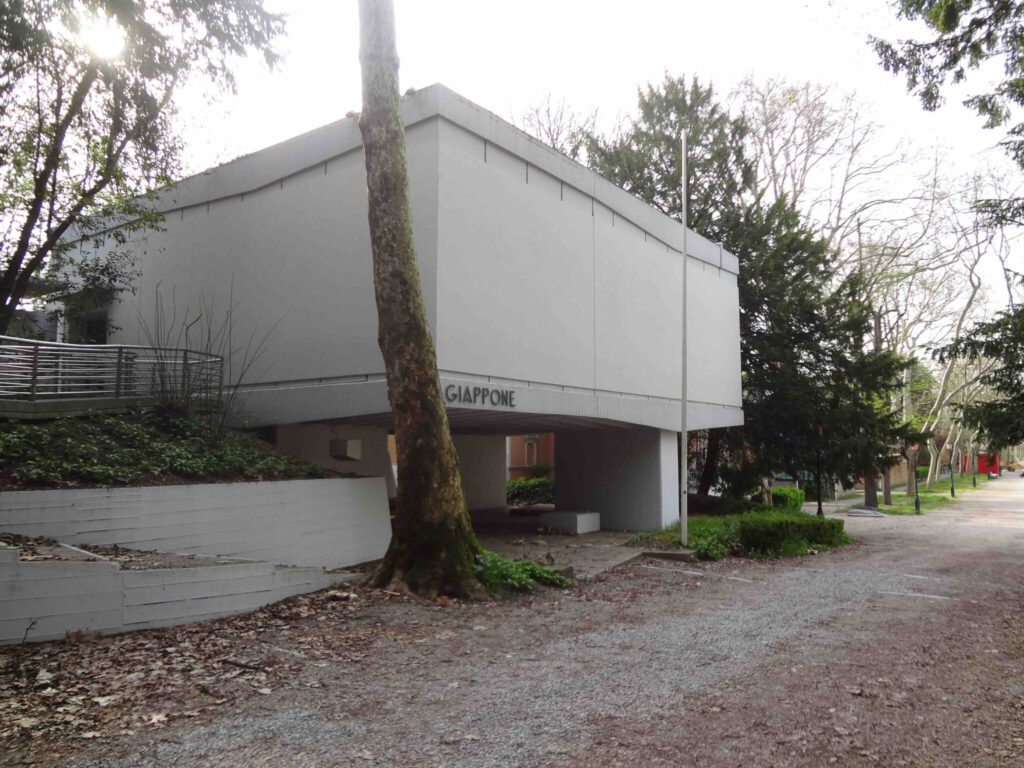
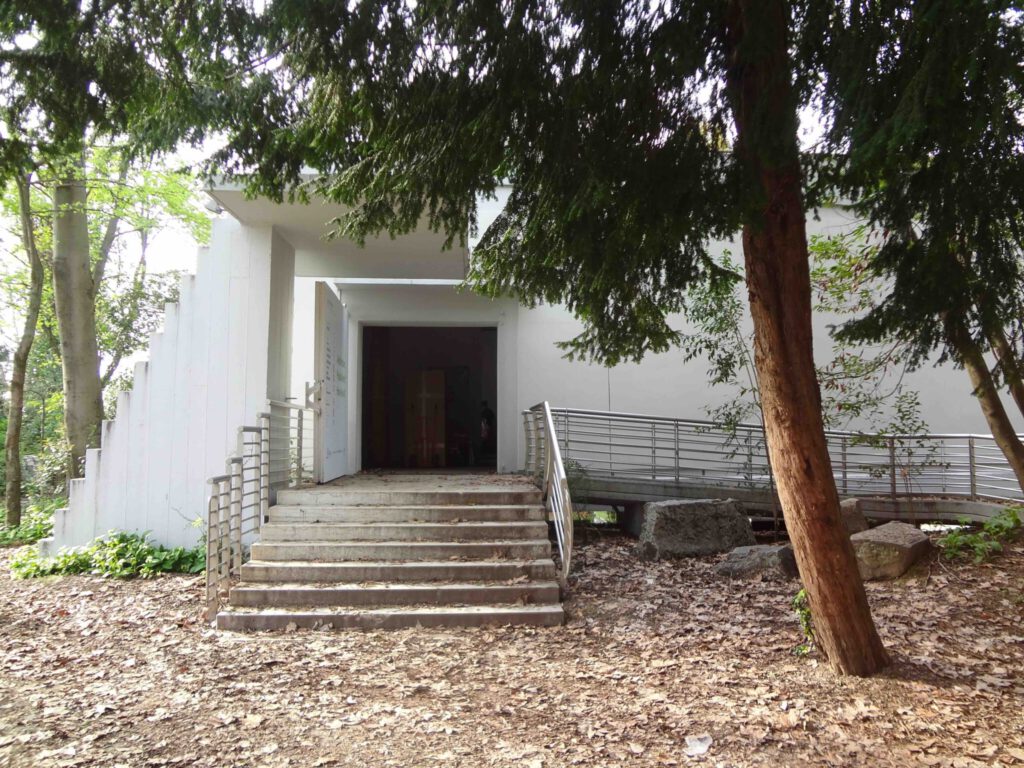
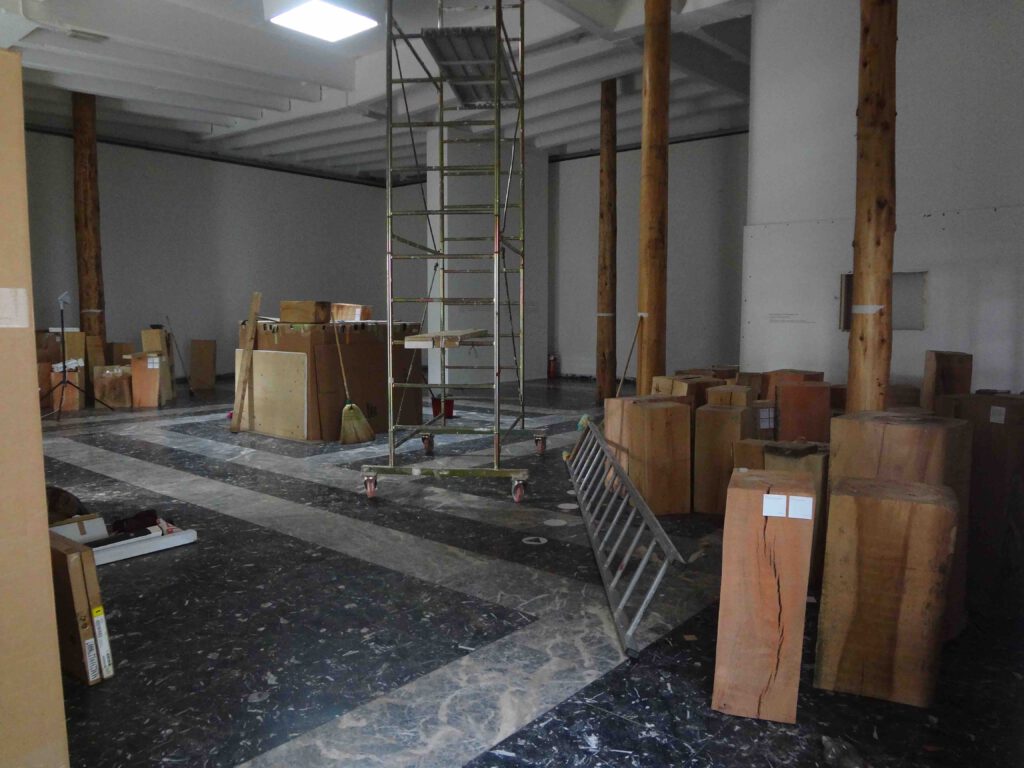
田中功起 TANAKA Koki @ Venice Biennale ヴェネツィア・ビエンナーレ Japan Pavilion 日本館, 2013年, rewarded with “Special Mention” by the Jury.
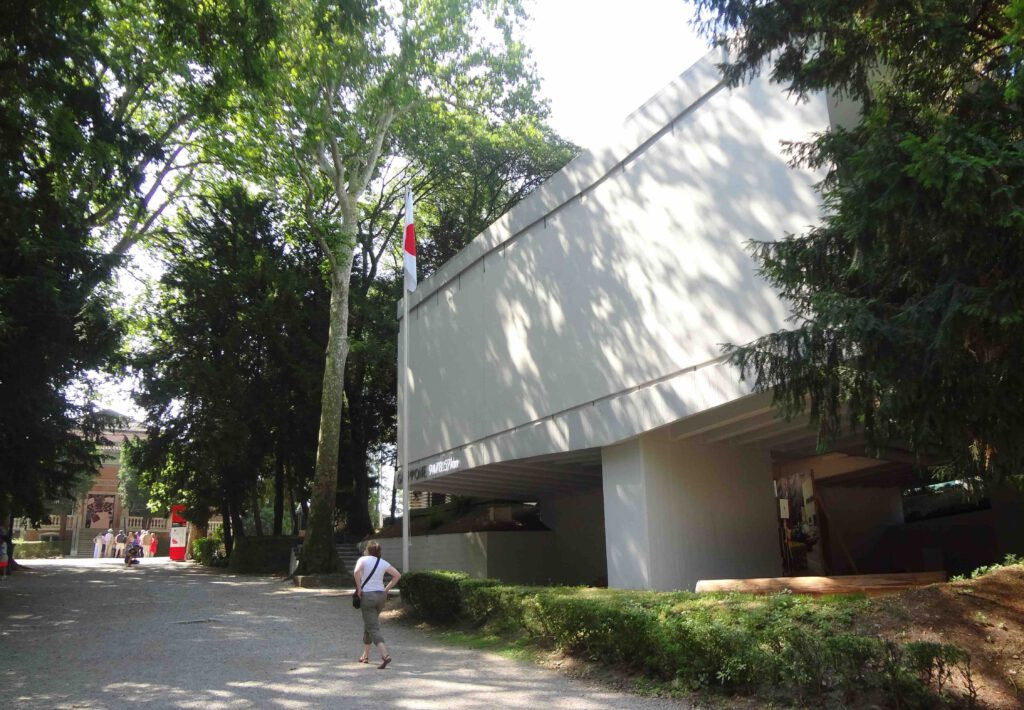










up-date 2023/11/2
artforum: FEATURES NOVEMBER 2023
THE SHAPE OF WATER
Yuko Mohri’s “Moré Moré (Leaky),” 2015–
By Dan Adler
https://www.artforum.com/features/dan-adler-yuko-mohri-s-more-more-leaky-2015-517945/
(end of up-date)
今日のおまけ today’s bonus:
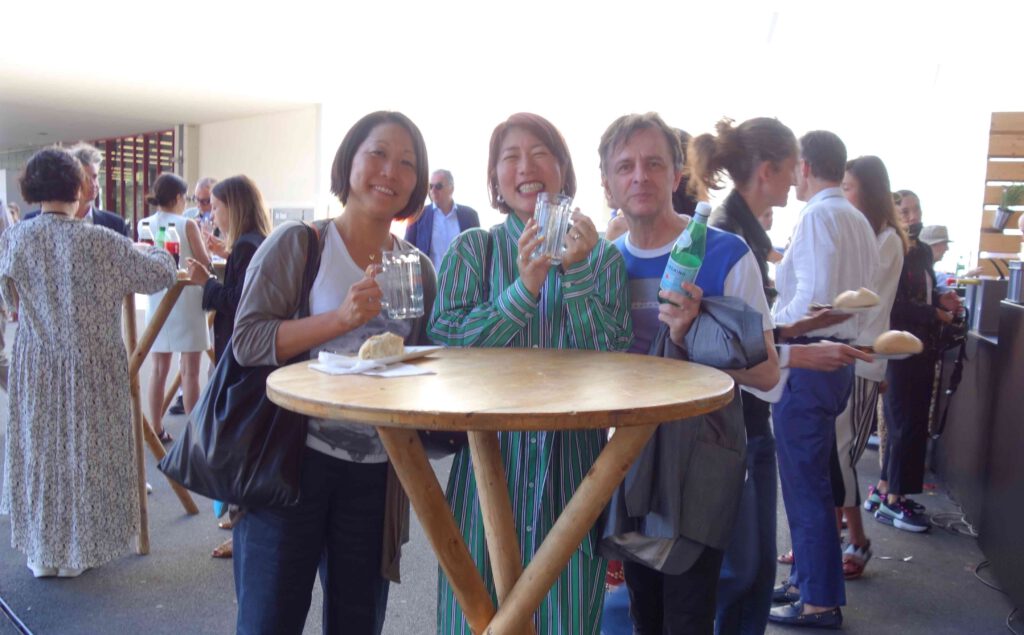

UP-DATE 2024/4/21
After artist TANAKA Koki 田中功起 won an award for the Japan Pavilion at the Venice Biennale, I thought MOHRI Yuko had the chance to receive a similar recognition, as in these days she is receiving raving, enthusiastic reviews for her installations in the Japan Pavilion.
For “Compose” in the Japan Pavilion of this year’s Venice Biennale, Mohri presents a critical commentary on environmental issues. Using materials sourced locally, from Venetian antique stores, furniture shops, grocery stores, liquor stores, and farmers and flea markets, Mohri utilized the whole pavilion as her own studio for a few months prior to the opening. The artist’s latest installations “Decomposition” and “Moré Moré (Leaky)” emerge as unique site-specific, one-time realisation presented for the Venice Biennale.
Let’s quote Julia Halperin from artnet:
“The Venice Biennale is a little like high school. Wandering around the Giardini and Arsenale, you quickly get a sense of which pavilions are the popular kids. Often, they have the slick, highly produced air of a girl who got a designer bag for her 16th birthday. In light of this dynamic, Yuko Mohri’s charming and subtle Japan Pavilion is especially refreshing. The artist created a funhouse of Rube Goldberg-like machines from everyday items, like plastic sheeting, buckets, and hoses. The display, part of an ongoing series by the artist, is inspired by the clever, improvisational ways that workers repair leaks in the Tokyo subway system. In Venice, these materials are harnessed as instruments in a quirky orchestra. A whirring fan makes a rubber tube quiver, rustling a shopping bag in turn; rain falling onto a plastic sheet jostles a set of wind chimes. Situated throughout the space are groupings of rotting fruit connected to electrodes; the fluctuating moisture content of the oranges, strawberries, and grapes is converted into synth sounds and flickering light. The installation activates all the senses and manages to do something lofty—embodying the interconnectedness of all things—with humor and verve.”
https://news.artnet.com/art-world/best-pavilions-2024-venice-biennale-2471412
ANDREW DURBIN @ Frieze Magazine:
Meanwhile, at the Japanese pavilion, Yuko Mohri mounted the biennial-stealing ‘Compose’, for which she created sculptures that generate music using rotting fruit. This immersive exhibition was wonderfully distracting as I wandered around the various objects and contraptions Mohri has constructed from wires, plastics, found furniture and decayed organic matter. I kept overstepping the demarcations meant to protect her sculpture from its viewers. I needed to get closer, even as I was politely told that I couldn’t; much of the work is so fragile, you can imagine even the gentlest nudge could send it crashing to the floor. Often, at events like these, in pavilions where the art barely hangs together, you can’t move on quick enough. Yet here, among Mohri’s atonal melodies, I wanted to linger a little longer and listen to a music so exactly right for this moment.
https://www.frieze.com/article/venice-biennale-2024-national-pavilions-review-litany-absences

The following pics and screenshots are taken from X, used in the context of “Creative Commons Attribution Noncommercial-NoDerivative Works, courtesy creative common sense”. One of Mohri’s representative galleries, namely Tanya Bonakdar Gallery, published two of the following pics on X. Further, artist INOMATA Aki posted spectacular documents, which had been used in the same art-historical context. Last but not least may I congratulate editor/writer FUKUSHIMA Natsuko 福島夏子 from Tokyo Art Beat, who closely covered the Venice Biennale for the Japanese audience. It seems no editor or writer from BT (Bijutsu-Techo 美術手帖) was on the spot. Neither well paid writers from Asahi Shimbun nor Yomiuri Shimbun, etc.. A shameful situation for Japan.
ヴェネチア・ビエンナーレ2024日本館、毛利悠子「Compose」を現地から速報レポート!
https://www.tokyoartbeat.com/articles/-/yuko-mohri-compose-report-202404
The last pic is taken today from Yuko’s X account.
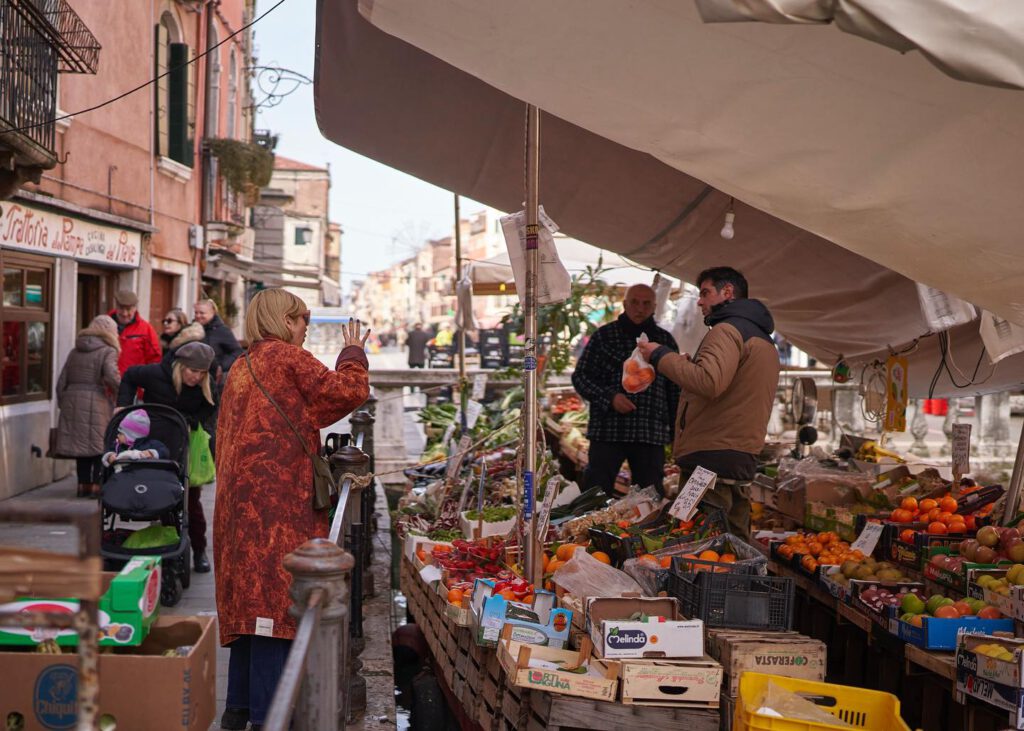
Courtesy, photo by kugeyasuhide (via Tokyo Art Beat)



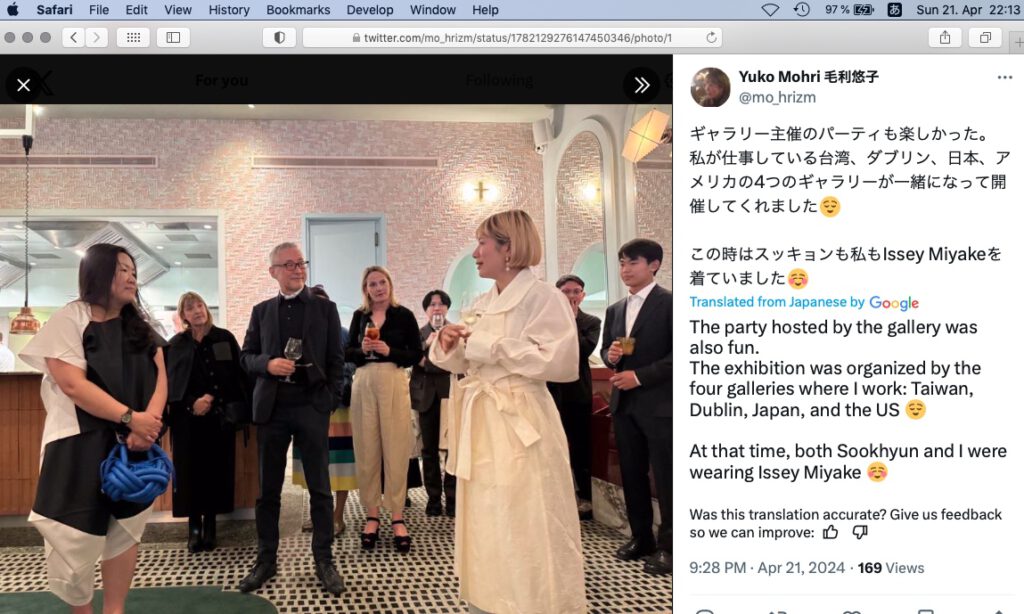
Link_https://twitter.com/mo_hrizm/status/1782129276147450346/photo/1

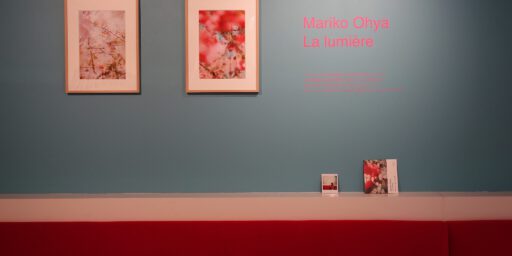
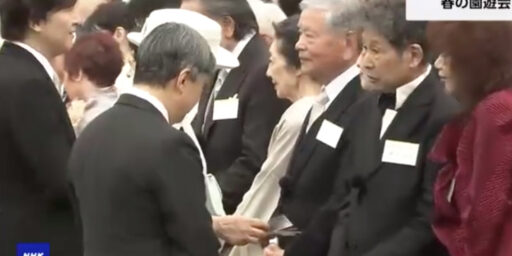



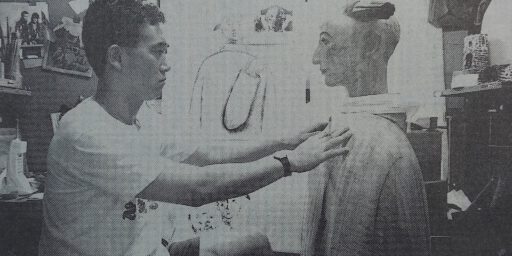
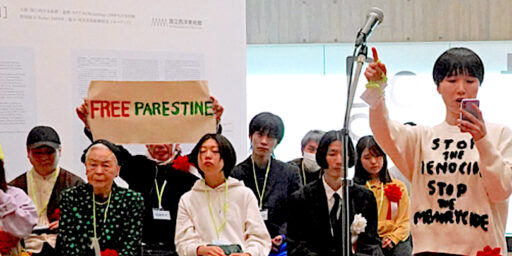
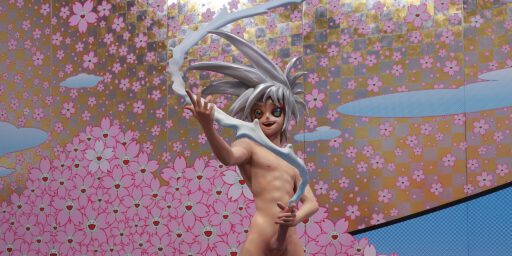
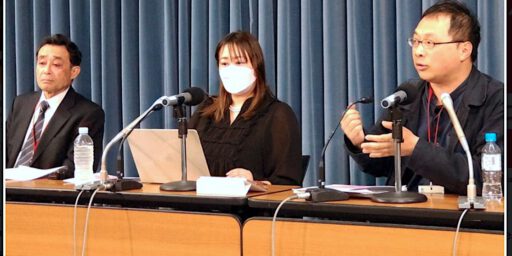

と-1963年生まれ、カルチュア・エンタテインメントの中西一雄社長-2024年の写真-512x256.jpg)